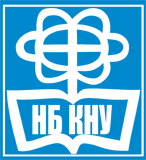Электронная библиотека
при поиске нашлись (81)
BD Chaurasia’s Human Anatomy, Volume 1 – Regional and Applied Dissection and Clinical. Upper Limb - Thorax
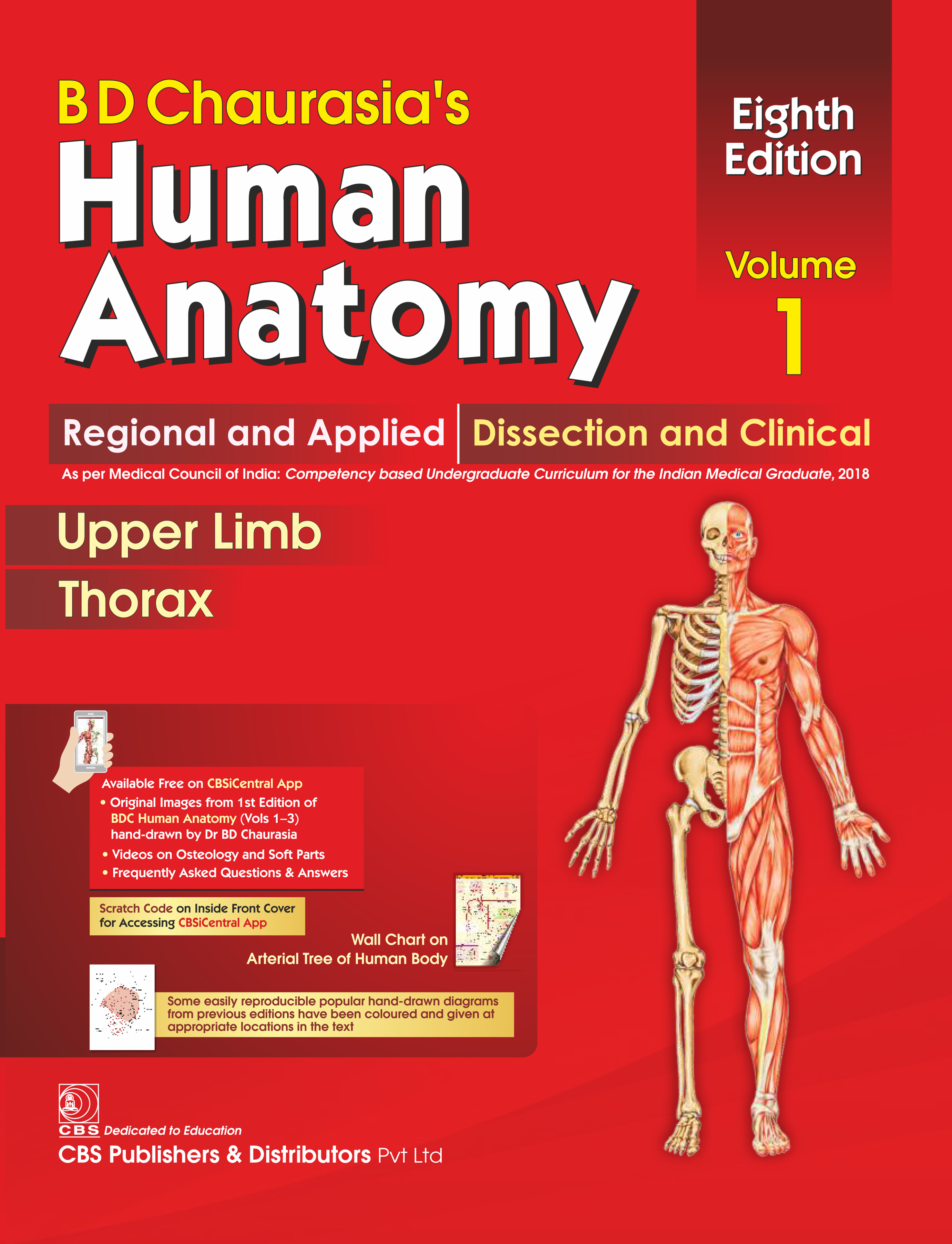
- Chaurasia, B. D. BD Chaurasia’s Human Anatomy, Volume 1 – Regional and Applied Dissection and Clinical. Upper Limb - Thorax: 8th Edition – New Delhi: CBS Publishers & Distributors Pvt Ltd, 2020. – 378 p
-
Аннотация
Human Anatomy Upper Limb Thorax is a comprehensive book for undergraduate students of Medicine. The book comprises of chapters on bones of upper limb, pectoral region, scapular region, forearm and hand, joints of upper limb, wall of thorax, thoracic cavity and the pleura, pericardium, and the heart. In addition, the book consists of several detailed diagrams and illustrations for the students to understand the concepts better. This book is essential for medical students preparing for various postgraduate medical entrance examinations.
BD Chaurasia’s Human Anatomy, Volume 2 – Regional and Applied Dissection and Clinical. Lower Limb - Abdomen and Pelvis

- Chaurasia, B. D. BD Chaurasia’s Human Anatomy, Volume 2 – Regional and Applied Dissection and Clinical. Lower Limb - Abdomen and Pelvis: 8th Edition – New Delhi: CBS Publishers & Distributors Pvt Ltd, 2020. – 562 p
-
Аннотация
This book has 3 sections that are 1. Lower limb, 2. Abdomen and 3. Pelvis. Gross anatomy and clinical aspect of these regions are covered in this volume of the book. You can use this book for gross anatomy, clinical anatomy and dissection of lower limb, abdomen and pelvis.
BD Chaurasia’s Human Anatomy, Volume 3 – Regional and Applied Dissection and Clinical. Head and Neck
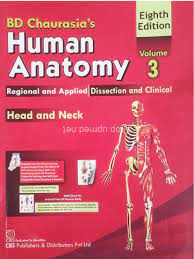
- Chaurasia, B. D. BD Chaurasia’s Human Anatomy, Volume 3 – Regional and Applied Dissection and Clinical. Head and Neck: 8th Edition – New Delhi: CBS Publishers & Distributors Pvt Ltd, 2020. – 640 p
-
Аннотация
Human Anatomy Upper Limb Thorax is a comprehensive book for undergraduate students of Medicine. The book comprises of chapters on bones of upper limb, pectoral region, scapular region, forearm and hand, joints of upper limb, wall of thorax, thoracic cavity and the pleura, pericardium, and the heart. In addition, the book consists of several detailed diagrams and illustrations for the students to understand the concepts better. This book is essential for medical students preparing for various postgraduate medical entrance examinations.
BD Chaurasia’s Human Anatomy, Volume 1 – Regional and Applied Dissection and Clinical. Upper Limb - Thorax
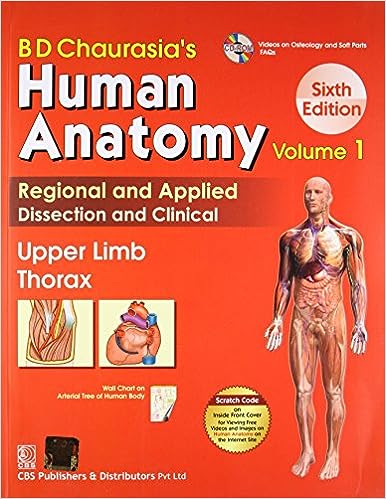
- Chaurasia, B. D. BD Chaurasia’s Human Anatomy, Volume 1 – Regional and Applied Dissection and Clinical. Upper Limb - Thorax: 6th Edition – New Delhi: CBS Publishers & Distributors Pvt Ltd, 2020. – 378 p
-
Аннотация
Human Anatomy Upper Limb Thorax is a comprehensive book for undergraduate students of Medicine. The book comprises of chapters on bones of upper limb, pectoral region, scapular region, forearm and hand, joints of upper limb, wall of thorax, thoracic cavity and the pleura, pericardium, and the heart. In addition, the book consists of several detailed diagrams and illustrations for the students to understand the concepts better. This book is essential for medical students preparing for various postgraduate medical entrance examinations.
BD Chaurasia’s Human Anatomy, Volume 2 – Regional and Applied Dissection and Clinical. Lower Limb - Abdomen and Pelvis
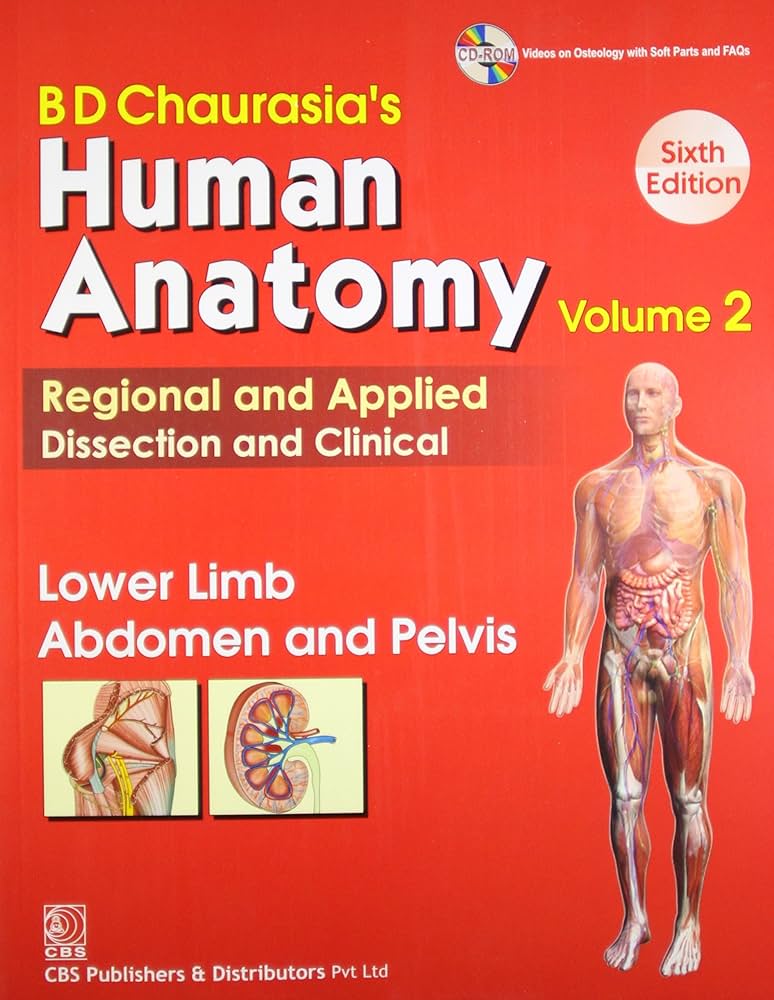
- Chaurasia, B. D. BD Chaurasia’s Human Anatomy, Volume 2 – Lower Limb, Abdoman and Pelvis: 6th Edition – New Delhi: Jaypee Brothers Medical Publishers (P) Ltd, 2013. – 463 p.
-
Аннотация
This book has 3 sections that are 1. Lower limb, 2. Abdomen and 3. Pelvis. Gross anatomy and clinical aspect of these regions are covered in this volume of the book. You can use this book for gross anatomy, clinical anatomy and dissection of lower limb, abdomen and pelvis.
BD Chaurasia’s Human Anatomy, Volume 3 – Regional and Applied Dissection and Clinical. Head and Neck
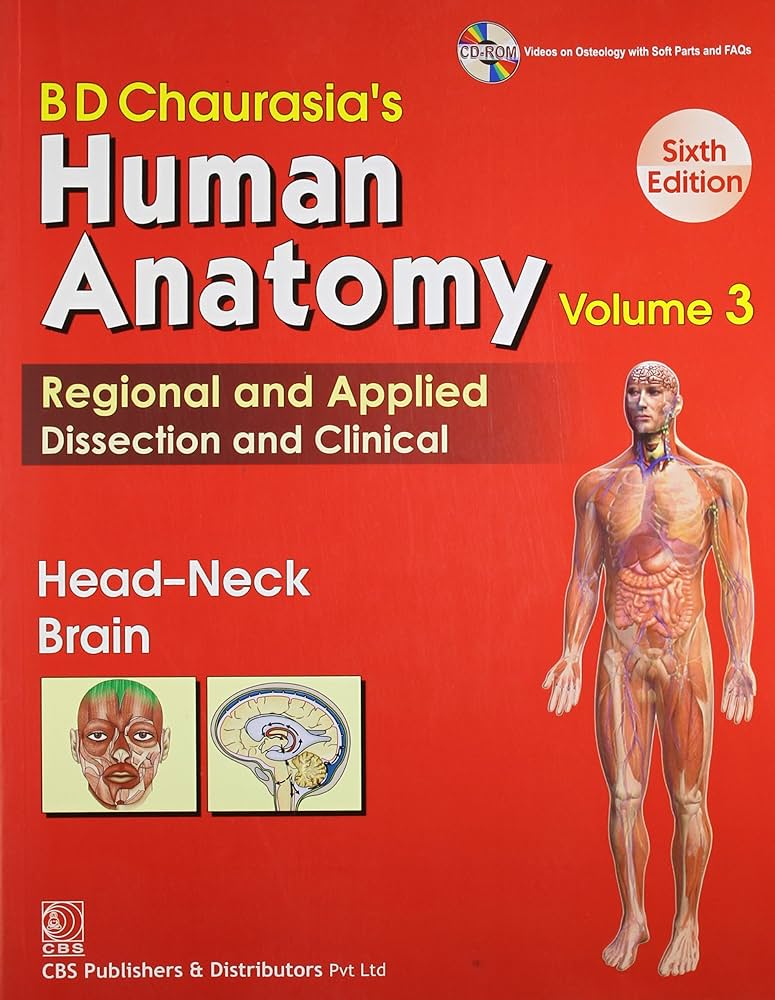
- Chaurasia, B. D. BD Chaurasia’s Human Anatomy, Volume 3 – Regional and Applied Dissection and Clinical. Head and Neck: 6th Edition – New Delhi, 2013. - 493 р.
-
Аннотация
Human Anatomy Upper Limb Thorax is a comprehensive book for undergraduate students of Medicine. The book comprises of chapters on bones of upper limb, pectoral region, scapular region, forearm and hand, joints of upper limb, wall of thorax, thoracic cavity and the pleura, pericardium, and the heart. In addition, the book consists of several detailed diagrams and illustrations for the students to understand the concepts better. This book is essential for medical students preparing for various postgraduate medical entrance examinations.
BD Chaurasia's Handbook of General anatomy: Handbook
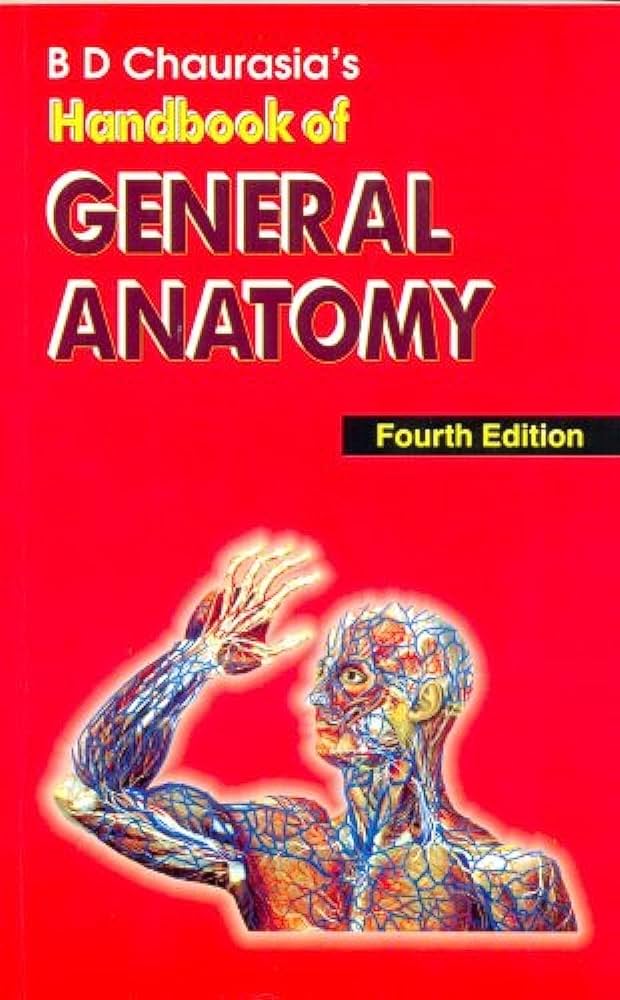
- Chaurasia, B. D. BD Chaurasia's Handbook of General anatomy: Handbook: 4th Edition. – New Delhi: Jaypee Brothers Medical Publishers (P) Ltd, 2009. - 262 p.
-
Аннотация
This tutorial is the most preferred and ideal tutorial, both in India and abroad. The best thing about this book is that, it is very precise, to the point and easy to understand. Not only this, but there are various diagrams and tables that makes it more easy for student to understand and revise/recall for exams.
Moore’s Clinical Anatomy Flash Cards: 2nd Edition.
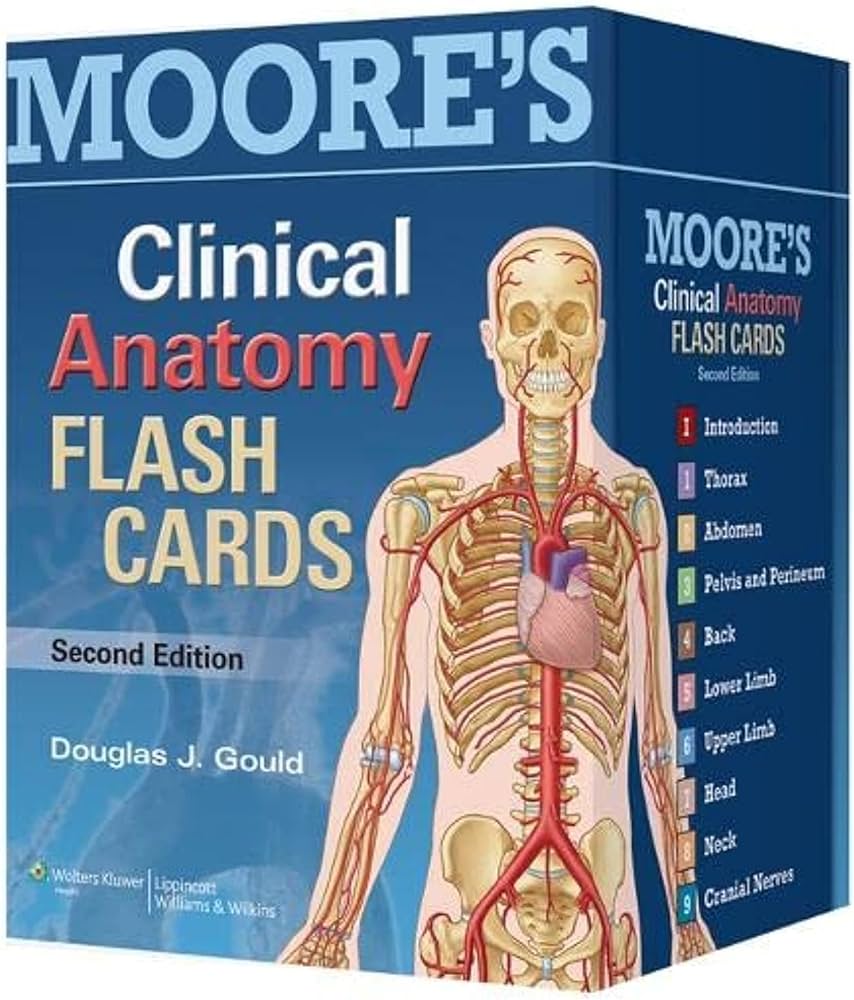
- Gould Douglas J. Moore’s Clinical Anatomy Flash Cards: 2nd Edition. – New York: Lippincott Williams & Wilkins, a Wolters Kluwer business, Philadelphia 2014. – 710 p
-
Аннотация
This publication contains information relating to general principles of medical care that should not be construed as specifi c instructions for individual patients. Manufacturers’ product information and package inserts should be reviewed for current information, including contraindications, dosages, and precautions.
Gray's Anatomy for Students: 2nd Edition.
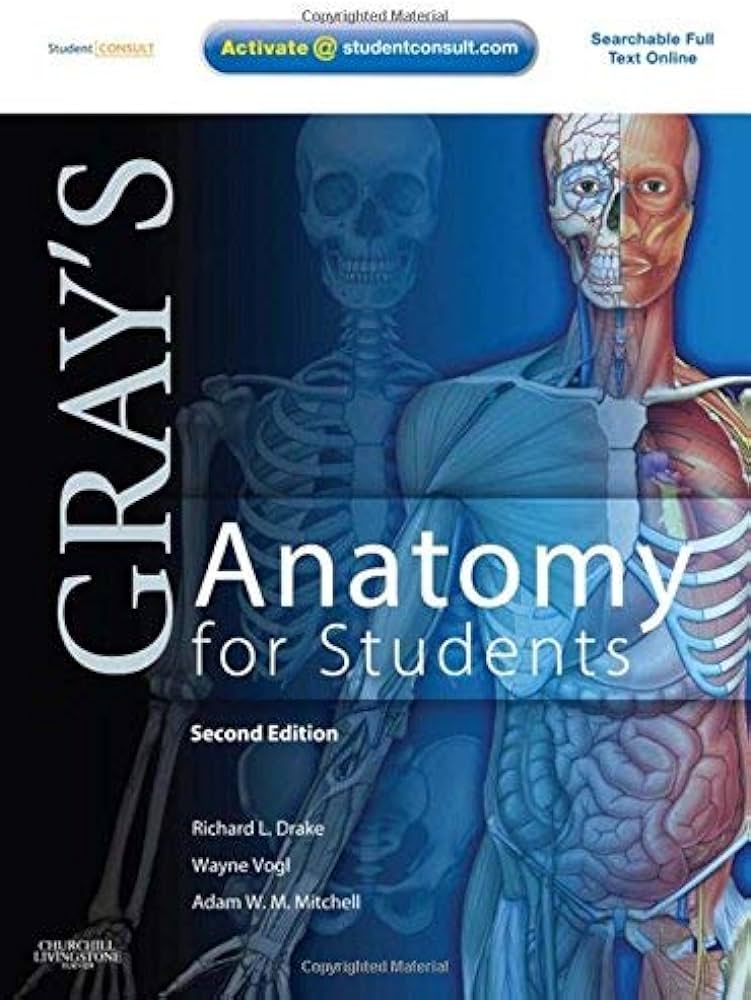
- Richard L. Drake, Wayne Vogl Gray's Anatomy for Students: 2nd Edition. – New York: Churchill Livingstone/Elsevier, 2010. – 1540 p
-
Аннотация
Easy to read, superbly illustrated, and clinically relevant, Gray's Anatomy for Students, 2nd Edition, is medical students' go-to text for essential information in human anatomy. This fully revised volume focuses on the core information students need to know, in an easy-access format and with additional multimedia tools that facilitate effective study and mastery of the material. A team of expert authors and global advisors share their extensive teaching and clinical experience, highlighted by more than 1,000 innovative, original illustrations throughout the text. Helps students understand the practical applications of anatomical concepts through unique coverage of surface anatomy, correlative diagnostic images, and clinical case studies. Presents anatomy logically by body region, and now offers bonus eBook chapters for each major body system to facilitate learning from a different perspective - covering the
Topographic anatomy and operative surgery.: 1st Edition
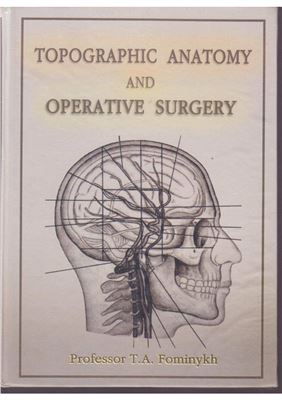
- Tatyana A. Fominykh. Topographic anatomy and operative surgery.: 1st Edition – Simferopol: Tavriya. 2006. – 316 p
-
Аннотация
Topographic Anatomy and Operative Surgery is the educational discipline containing systematized scientific knowledge and techniques in the field of topographic anatomy and operative surgery, studying the layer anatomy of organs regions, topography of the organs, principles and techniques of surgical procedures.
Harper's Illustrated Biochemistry: A Lange medical book: 28th edition.
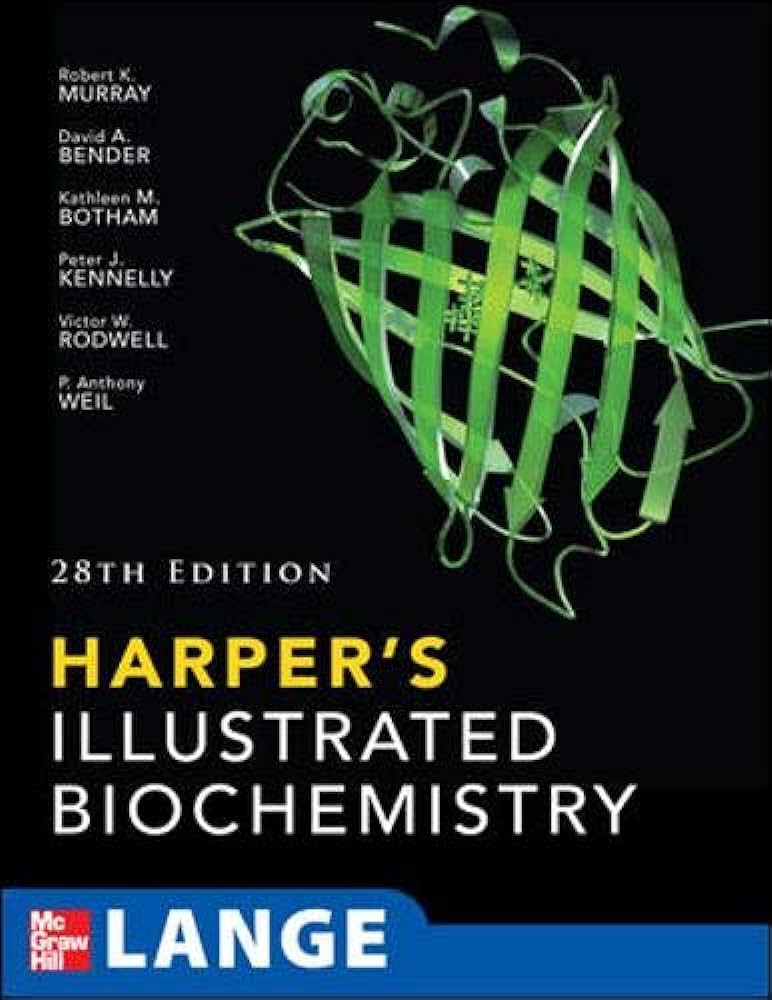
- Harper's Illustrated Biochemistry: A Lange medical book: 28th edition. - New York: McGraw-Hill Companies, Inc., 2009. - 693 p.
-
Аннотация
Many biochemical books include a section with clinical notes, which is extremely important for medical students. And Harper's medical biochemistry is one of them. Here you can learn about all the chemical reactions and various mechanisms of the human body.
Biochemistry

- Satyanarayana, U. Biochemistry: 3rd edition. – Kolkata: Books and Allied (P) Ltd., 2007. - 792 p.
-
Аннотация
This textbook ‘Biochemistry’ has become one of the most preferred text books (in India and many other countries) for the students as well as teachers in medical, biological and other allied sciences. The book has undergone three editions, several reprints, and revised reprints in a span of 13 years. There are many biochemistry textbooks in the market. Some of them are purely basic while others are applied, and there are very few books which cover both these aspects together. For this reason, the students learning biochemistry in their undergraduate courses have to depend on multiple books to acquire a sound knowledge of the subject. This book, ‘Biochemistry’ is unique with a simultaneous and equal emphasis on basic and applied aspects of biochemistry. This textbook offers an integration of medical and pure sciences, comprehensively written to meet the curriculum requirements of undergraduate courses in medical, dental, pharmacy, life-sciences and other categories (agriculture, veterinary, etc.). This book is designed to develop in students a sustained interest and enthusiasm to learn and develop the concepts in biochemistry in a logical and stepwise manner. It incorporates a variety of pedagogic aids, besides colour illustrations to help the students understand the subject quickly and to the maximum. The summary and biomedical/clinical concepts are intended for a rapid absorption and assimilation of the facts and concepts in biochemistry. The self-assessment exercises will stimulate the students to think rather than merely learn the subject. In addition, these exercises (essays, short notes, fill in the blanks, multiple choice questions) set at different difficulty levels, will cater to the needs of all the categories of learners.
Textbook of biochemistry
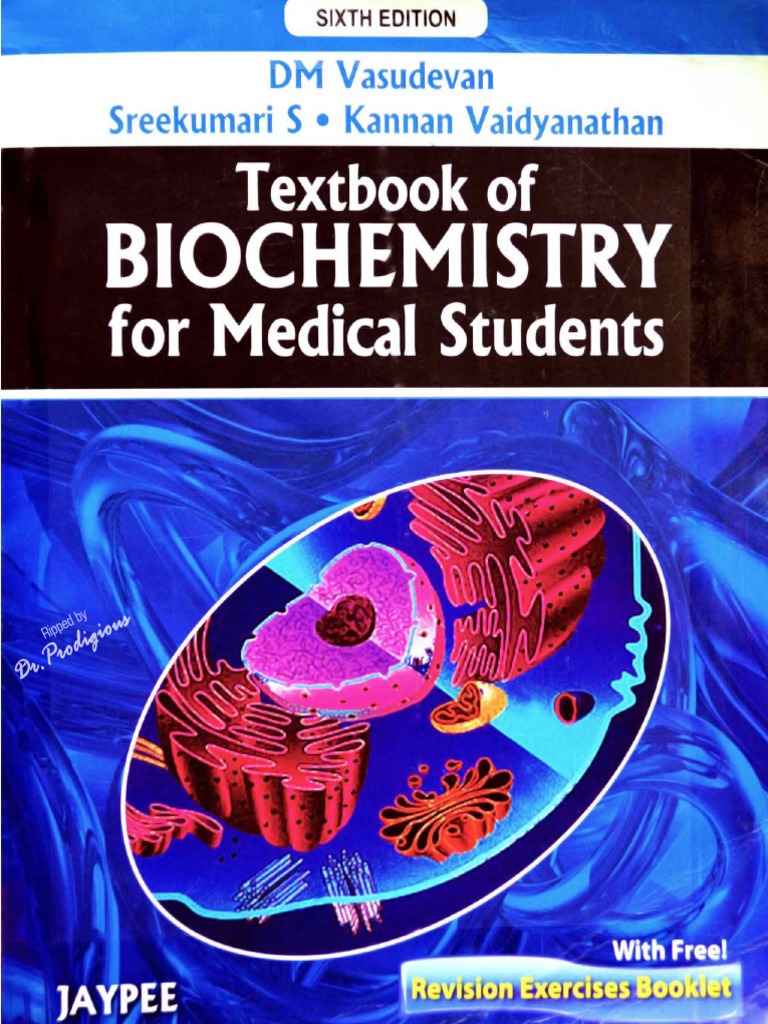
- Textbook of biochemistry: 6th Edition For Medical Students– New Delhi: Jaypee Brothers Medical Publishers (P) Ltd, 2011. - 657 p
-
Аннотация
This book contains an amalgamation of the essentials of basic biochemistry along with the advanced knowledge in the frontiers of molecular biology. The first edition of the book was published in 1995, and is now running the 6th edition. The book is now accepted as a standard textbook in all the medical colleges in India and abroad. Total of more than 100,000 copies have already been sold. The book has been designed with 7 sections. Section A deals with chemical basis of life. Section B is devoted to general metabolism. Section C describes clinical and applied biochemistry. Section D develops the clinical nutrition. Section E elaborates molecular biology. Section F denotes hormones and homeostasis. Section G is for advanced biochemistry. The 6th edition contains about 1,100 figures, 230 tables and 200 boxes, altogether making the book very student-friendly. Much emphasis has been given on clinical aspect of biochemistry, and the book is written aiming the students who are going to become practicing physicians. For example, chapter 24 gives the metabolic alterations in Diabetes Mellitus and in pre-diabetic states. Chapter 25 shows the relationship of cholesterol and lipoproteins with myocardial infarction. Chapter 26 gives the routine and special investigations done to identify liver diseases. Chapter 27 contains the alterations of parameters during kidney disease. Chapter 29 identifies the alterations in acid base balance and the life threatening conditions leading to changes in blood pH. Chapters on clinical chemistry have been extensively updated and clinically relevant points were further added. Out of the total 600 pages, more than 200 pages are devoted to the Clinical Biochemistry and Nutrition. Another 75 pages are devoted to the advances in Molecular Biology. Page 265 gives the details of cardiac markers, the alterations in serum enzymes during myocardial infarction. This text will keep the reader updated with important advances in the field of clinical biochemistry in a comprehensive but readable format.
ABC of clinical electrocardiography

- Francis Morris ABC of clinical electrocardiography: 1st Edition – London: BMJ Publishing Group, 2003. – 89 p
-
Аннотация
Cover image depicts a chest x ray and electrocardiogram trace Composite image of an electrocardiogram trace showing termination of atrioventricular nodal re-entrant tachycardia, overlaid onto a false-coloured chest x ray With permission from Sheila Terry/Science Photo Library
DC Dutta’s Textbook of Gynecology including Contraception

- DC Dutta’s Textbook of Gynecology including Contraception: 7th Edition – New Delhi: The Health Sciences Publisher, 2016. – 588 p
-
Аннотация
Medical knowledge and practice change constantly. This book is designed to provide accurate, authoritative information about the subject matter in question. However, readers are advised to check the most current information available on procedures included and check information from the manufacturer of each product to be administered, to verify the recommended dose, formula, method and duration of administration, adverse effects and contraindications. It is the responsibility of the practitioner to take all appropriate safety precautions. Neither the publisher nor the author(s)/editor(s) assume any liability for any injury and/or damage to persons or property arising from or related to use of material in this book.
Larsen's Human Embryology
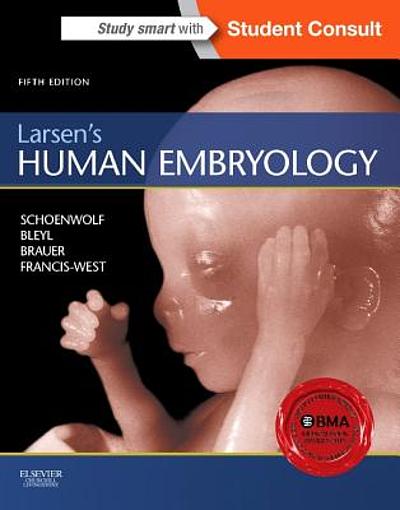
- Larsen's Human Embryology: 5th Edition - Philadelphia, 2015. - 526 p.
-
Аннотация
Larsen's Human Embryology works as a well-organized, straightforward guide to this highly complex subject, placing an emphasis on the clinical application of embryology and presenting it in an easily digestible manner. Ideal for visual students, this updated medical textbook includes a superior art program, brand-new online animations, and high-quality images throughout; clear descriptions and explanations of human embryonic development, based on all of the most up-to-date scientific discoveries and understanding, keep you abreast of the latest knowledge in the field.
Atlas of Human Anatomy
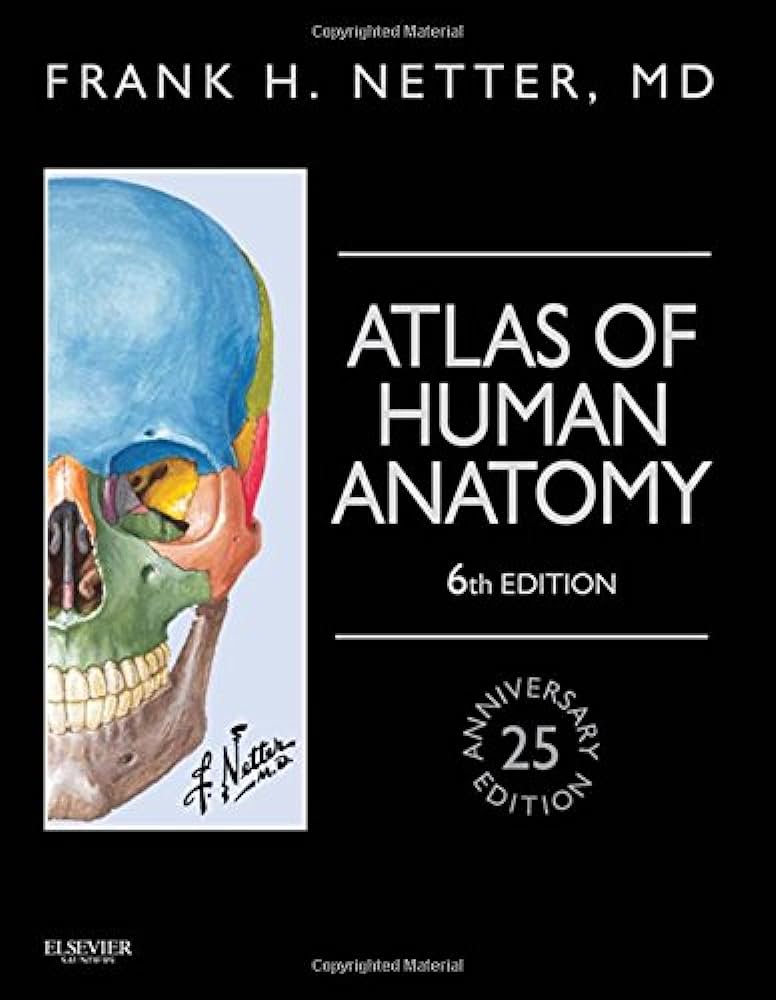
- Netter, Frank H. Atlas of Human Anatomy: 6th Edition. – Philadelphia,: Elsevier Inc. 2014.-769p.
-
Аннотация
"Atlas of human body" - a popular publication, which provides information about the physical structure of man. It is intended for a wide audience, and therefore easy to understand. Working with a book, you can understand how the human body works.
Atlas of histology with Functional Correlations
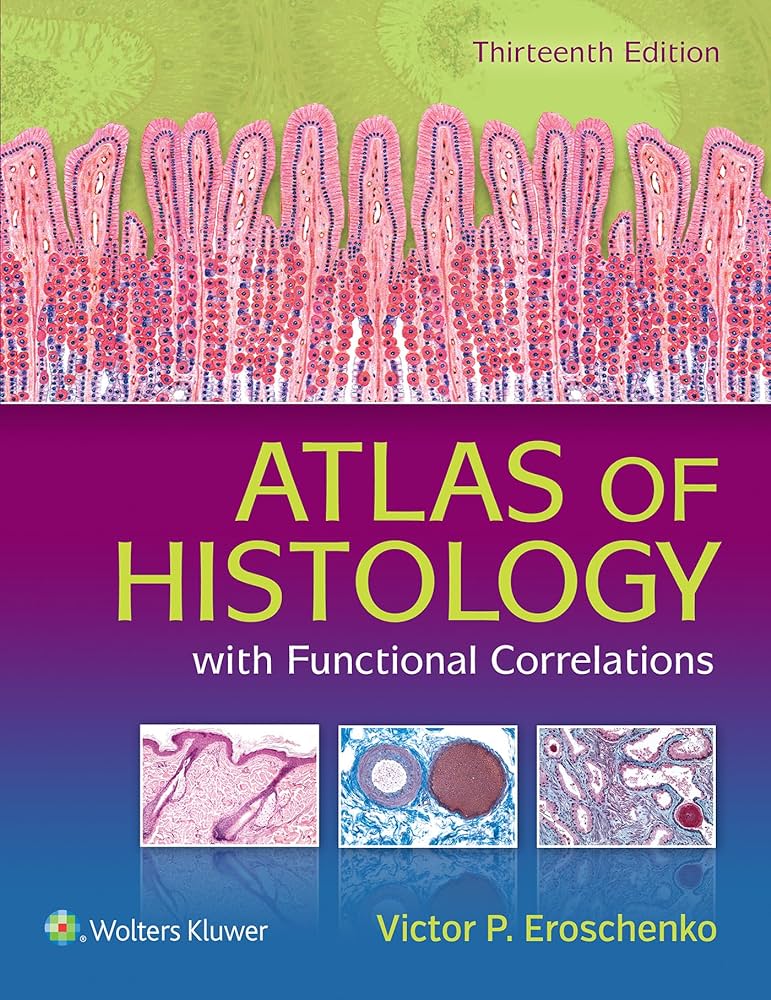
- Victor P. Eroschenko Atlas of histology with Functional Correlations: 13th Edition - Philadelphia, 2017. - 1102 p.
-
Аннотация
The thirteenth edition of Atlas of Histology with Functional Correlations (formerly diFiore’s Atlas of Histology with Functional Correlations) continues to provide a colorful and expanded atlas of histologic images for medical, veterinary, dentistry, and pathology as well as students of the biological sciences. As in previous editions, numerous comments from reviewers were helpful in suggesting improvement to the text and images of the atlas. Keeping these suggestions in mind, the composite and colorful illustrations of cells, tissues, and organs that made this atlas popular are maintained in the thirteenth edition. In addition, numerous photomicrographs were added throughout. While most of the images were prepared with light microscopy, other images with transmission and scanning microscopy are also included where it was necessary to show more precise and detailed morphology of different structures not visible with light microscopy. The rapid advance in scientific research continues to produce volumes of new information that further our understanding of fundamental biological functions of cells as well as their subcellular and molecular components. Thus, in our contemporary era, the study of histology requires more than the recognition and identification of structural characteristics in different organs but also learning and understanding their diverse dynamics and functional correlations that maintain the homeostasis of living organisms.
Medical Terminology: An Illustrated Guide
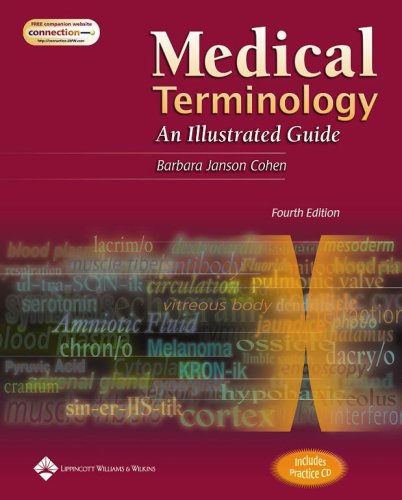
- Cohen, Barbara Janson Medical Terminology: An Illustrated Guide: 4th Edition - Philadelphia, 2003. - 745 p.
-
Аннотация
Now in its Fourth Edition, this richly illustrated guide serves as an introduction to medical terminology. It provides extensive coverage of those terms relating to normal structure and function, disorders, diagnosis and treatment. Numerous illustrations throughout the book -- most in brilliant four-color -- enhance informative coverage of normal anatomy, physiology and clinical material. The book comes packaged with a CD-ROM containing a Stedman’s pronunciation glossary, and exercises for students. The free faculty ancillary package includes an image bank, transparencies, and an instructor’s manual packaged with a test generator CD-ROM. Visit connection.LWW.com/go/cohen4e for more information.
Latin and Fundamentals of Medical Terminology
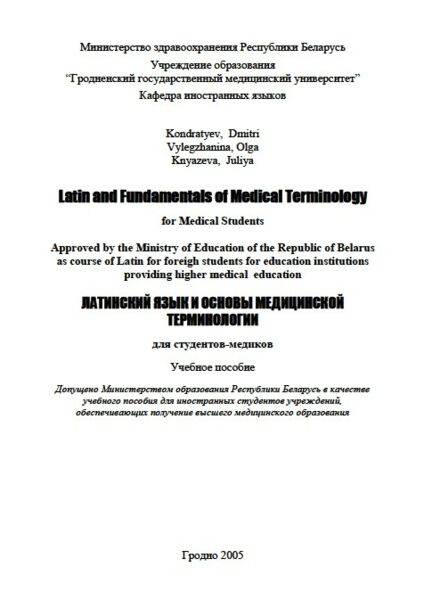
- Kondratyev, Dmitri Latin and Fundamentals of Medical Terminology. For Medical Students– Grodno: ГрГМУ, 2005. – 250 p.
-
Аннотация
Textbook “Latin and Fundamentals of Medical Terminology” is designed to be a comprehensive textbook covering the entire curriculum for medical students in this subject. The course “Latin and Fundamentals of Medical Terminology” is a two-semester course that introduces students to the Latin and Greek medical terms that are commonly used in Medicine. The aim of the two-semester course is to achieve an active command of basic grammatical phenomena and rules with a special stress on the system of the language and on the specific character of medical terminology, and that to the extent that enables an active use of Latin and Greek medical terms and promote further own work with them.
A History of Medicine
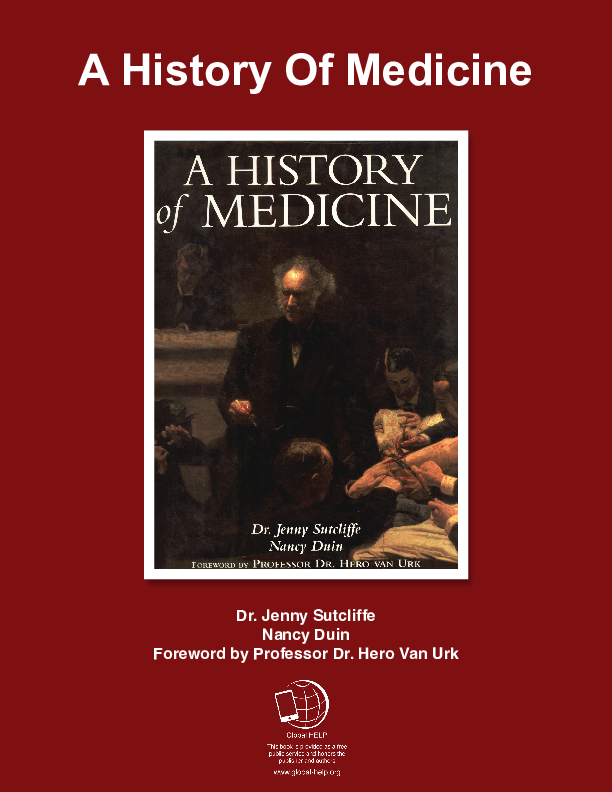
- A History of Medicine. From Prehistory to the Year 2020- Morgan Samuel Editions.- London, 1992.- 258 p.
-
Аннотация
This book is intended solely as a work of reference on the history and possible future of medicine.
Case Studies in Adult Intensive Care Medicine
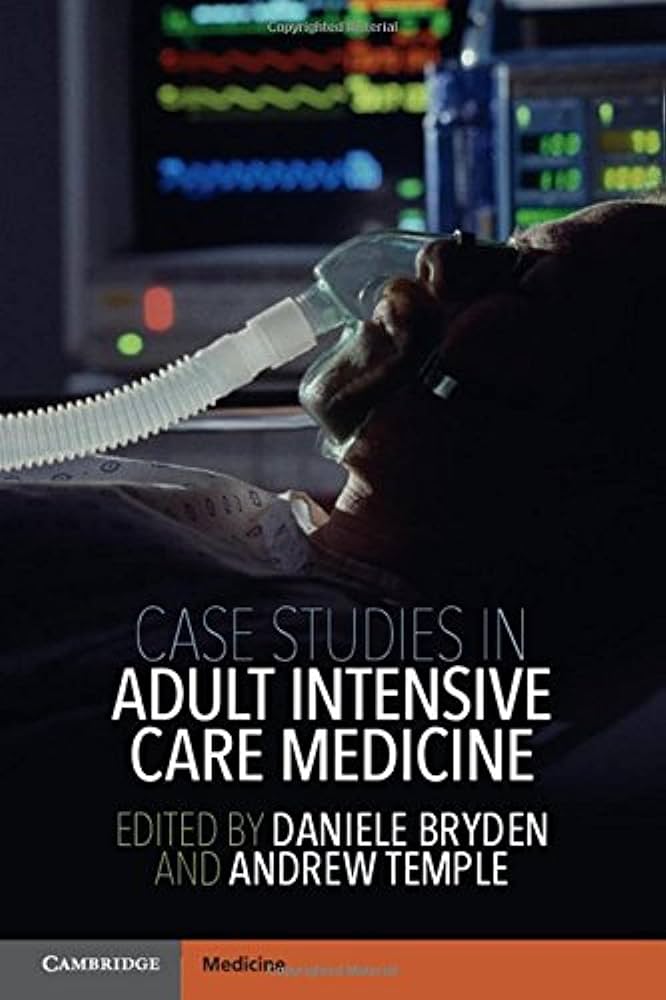
- Bryden Daniele. Case Studies in Adult Intensive Care Medicine: 1st Edition – London: Cambridge University Press, 2017. – 383 p
-
Аннотация
In their book, editors Bryden and Temple1 present an excellent review of the most common types of cases seen in the intensive care unit (ICU). The reviewed topics are relevant for physicians taking care of patients in the neuro-ICU, surgical ICU, trauma ICU, and medical ICU. It provides an excellent overview of critical illnesses and is recommended for students, residents, and fellows preparing for exams, as well as practicing intensivists who wish to revisit these topics.
Davidson’s Principles and Practice of Medicine. Any screen. Any time. Any where
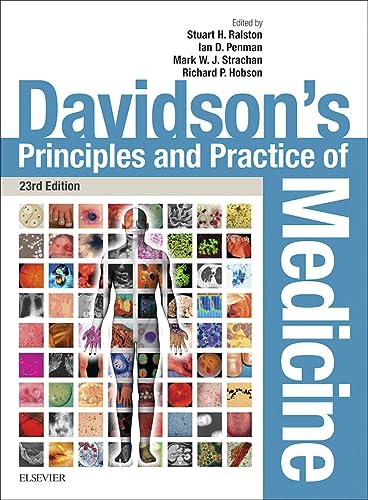
- Stuart H. Ralston Davidson’s Principles and Practice of Medicine. Any screen. Any time. Any where.: 23rd Edition – Edinburgh: Elsevier, Inc., 2018. – 1440 p
-
Аннотация
This text on clinical medicine has been updated to aid learning and revision. Topics covered include genetic, climatic and environmental factors in disease, and endocrine and metabolic diseases, whilst a new chapter on geriatric medicine has also been included.
The Language of Medicine
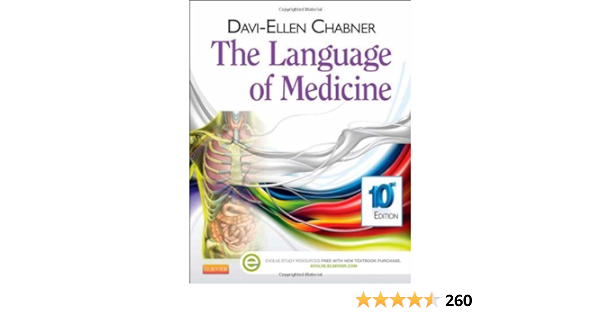
- Davi-Ellen Chabner BA MAT. The Language of Medicine: 10th Edition – St. Louis: Elsevier Inc., 2014. – 1076 p
-
Аннотация
Bring medical terminology to life with Davi-Ellen Chabner's bestselling The Language of Medicine, 10th Edition By presenting medical terms within the context of the body's anatomy and physiology, and in health and disease, this proven resource makes it easy to learn a working medical vocabulary built on the most frequently encountered prefixes, suffixes, and combining forms. Practical exercises and case studies demonstrate how medical terms are used in practice. Add an engaging student Evolve website with medical animations and videos, word games, flash cards, and more, and you'll be ready to communicate confidently in the clinical setting and succeed in your healthcare career.
Textbook of Family Medicine

- Robert E. Rakel. Textbook of Family Medicine: 9th Edition – Philadelphia: Elsevier, 2016. – 1447 p
-
Аннотация
This ninth edition of the Textbook of Family Medicine, edited by Drs. Robert E. Rakel and David P. Rakel, remains your #1 choice for complete guidance on the principles of family medicine, primary care in the community, and all aspects of clinical practice. Ideal for both residents and practicing physicians, this medical reference book includes evidence-based, practical information to optimize patient care and prepare you for the ABFM exam. A clean, quick-reference layout makes it easy for you to put information to work immediately in your practice.
Siegenthaler' Differential Diagnosis in Internal Medicine From Symptom to Diagnosis
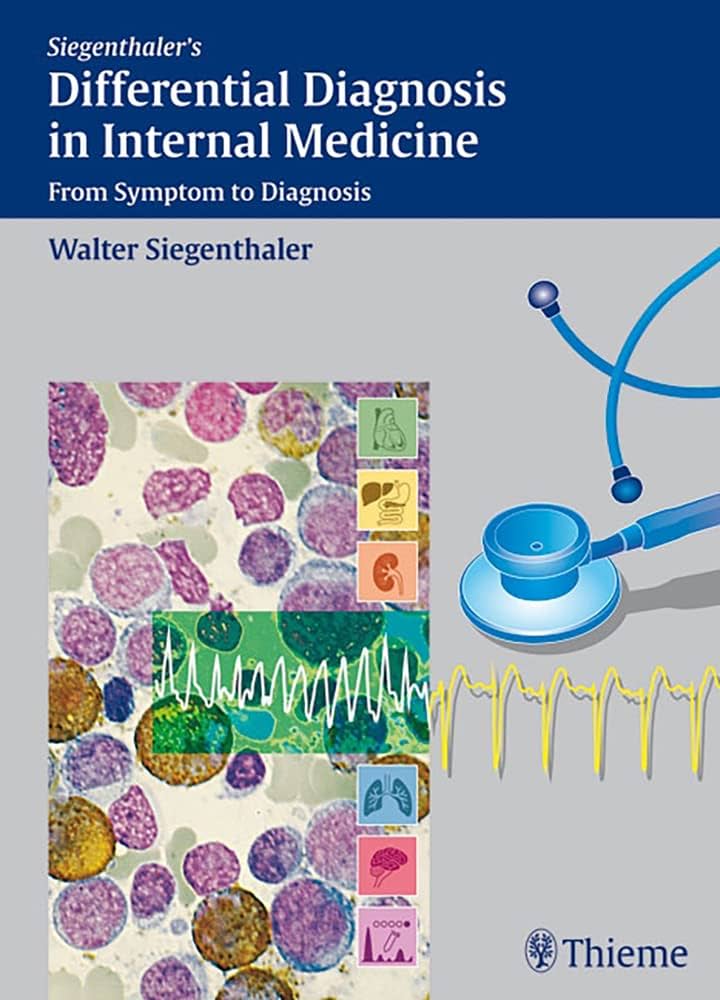
- Walter Siegenthaler, MD Siegenthaler' Differential Diagnosis in Internal Medicine From Symptom to Diagnosis- Stuttgart, 2007.- 1143 p.
-
Аннотация
This book encompasses differential diagnosis across the spectrum of internal medicine, covering dermatology, neurology, and rheumatology, and provides the very latest knowledge including pathophysiological aspects. In contrast to encyclopedically structured textbooks, this book traces the path from symptom to diagnosis, just as the physician encounters the situation in the hospital and in the office. With this pragmatic approach—starting from the symptom(s)—the physician will usually succeed in substantiating the suspected diagnosis. Using this method, Siegenthaler’s Differential Diagnosis in Internal Medicine guides the reader through the differential diagnostic challenges in the entire field of internal medicine, including dermatology, neurology, and rheumatology. The book incorporates many relevant and instructive illustrations, tables, graphics, and algorithms, all contributing to the process of narrowing down a definitive diagnosis.
Essential Microbiology
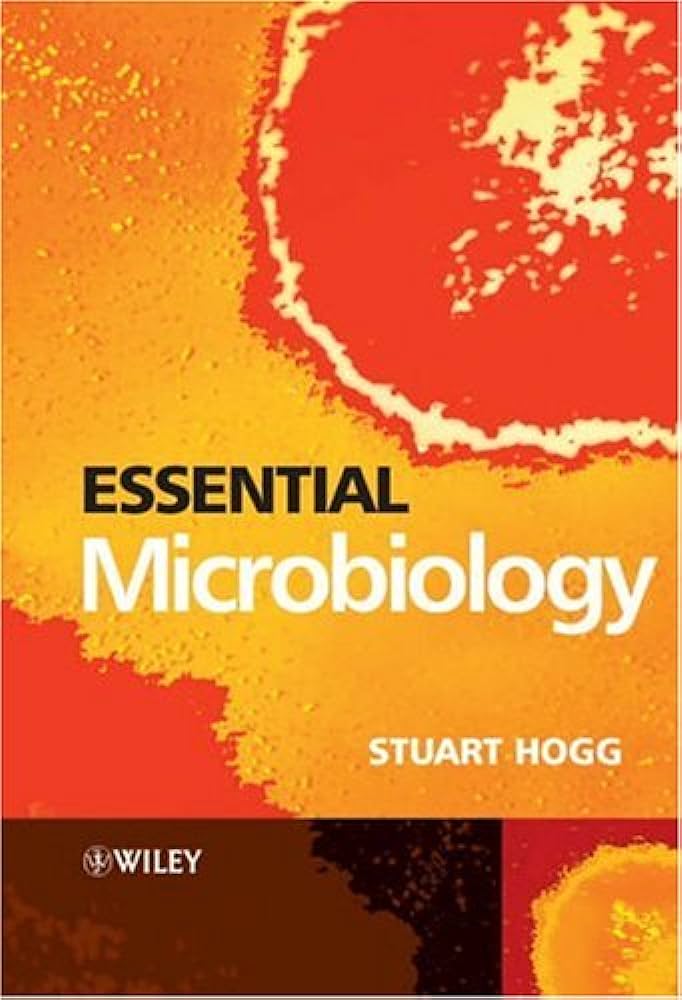
- Stuart Hogg Essential Microbiology:– Chichester: John Wiley & Sons Ltd, 2005. – 481 p
-
Аннотация
Essential Microbiology Edition is a fully revised comprehensive introductory text aimed at students taking a first course in the subject. It provides an ideal entry into the world of microorganisms, considering all aspects of their biology (structure, metabolism, genetics), and illustrates the remarkable diversity of microbial life by devoting a chapter to each of the main taxonomic groupings. The second part of the book introduces the reader to aspects of applied microbiology, exploring the involvement of microorganisms in areas as diverse as food and drink production, genetic engineering, global recycling systems and infectious disease. Essential Microbiology explains the key points of each topic but avoids overburdening the student with unnecessary detail. Now in full colour it makes extensive use of clear line diagrams to clarify sometimes difficult concepts or mechanisms. A companion web site includes further material including MCQs, enabling the student to assess their understanding of the main concepts that have been covered.
Medical Microbiology

- Fritz H. Kayser, M.D. Medical Microbiology- Stuttgart, 2005. - 725 p.
-
Аннотация
While medical and hygienic developments have driven down the mortality rates of infectious diseases, pathogenic microorganisms are still a major factor in everyday clinical practice. They are still the most frequent cause of death in Third World countries. New and incurable infectious diseases are a worldwide problem. It is inescapable, therefore, that modern medicine must redouble its efforts to understand the relationship between microorganisms and humans and continue to lead the search for new therapies. The following five subject areas are covered: Immunology Bacteriology Mycology Virology Parasitology This book provides a clearly focused and richly detailed review of the entire field of medical microbiology. It is both a textbook for students of medicine and dentistry and a useful companion for medical technicians and laboratory assistants, both at school and in the laboratory. It will also serve as a handy work of reference for clinical practitioners. The book is structured with teachability in mind: The many color illustrations and microscopic images render complex themes readily accessible. Summaries at the beginning of every chapter, a color-coded reference guide and detailed diagnostic tables make this an excellent sourcebook for rapid learning and quick reference. A list of important internet addresses in the appendix will help the book's users keep abreast of cutting-edge research.
Clinical Neurology (LANGE Clinical Medicine)
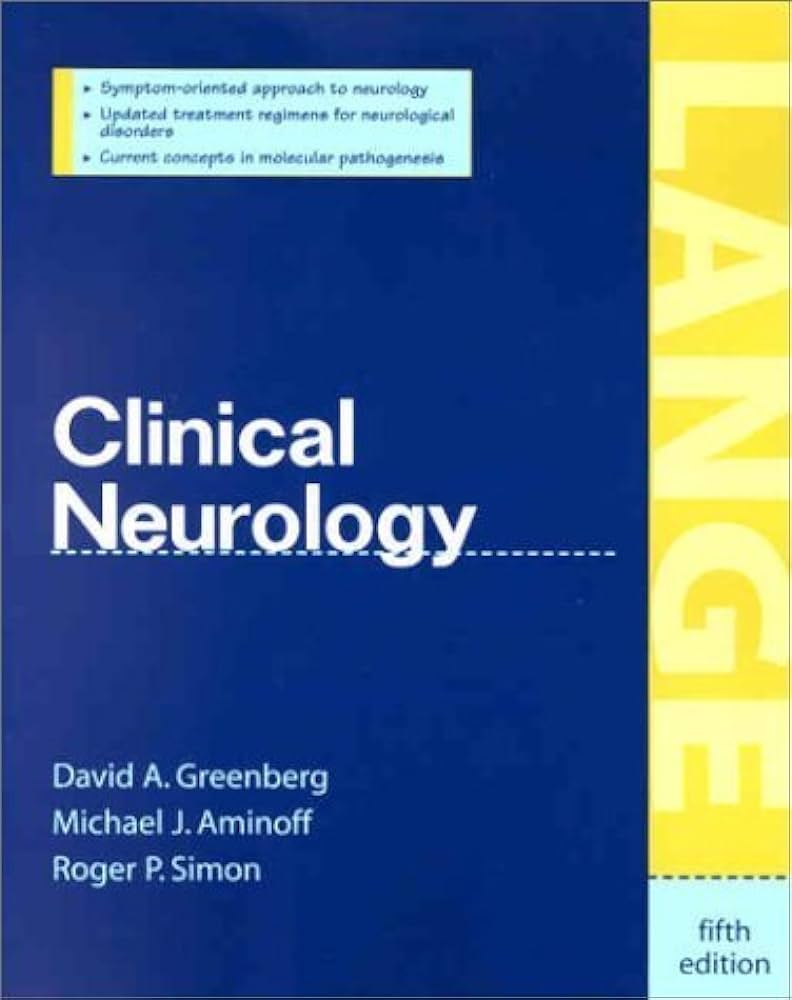
- David A. Greenberg. Clinical Neurology (LANGE Clinical Medicine): 5 th Edition. – Novato: Mcgraw-Hill Publishing Co, 2002. – 236 p
-
Аннотация
The fifth edition of Clinical Neurology, like its predecessors, offers a problem-oriented approach to neurology based on the authors' experience in teaching medical students and house staff at the University of California, San Francisco. Chapters are organized according to problems such as headache, seizures, stroke, and coma, because these are the conditions for which patients usually seek medical care. Careful history taking and neurologic examination are emphasized, as these remain the cornerstones of neurologic diagnosis, even in an era of technologic diagnostic advances. The need to update this book arises from two main sources: rapid expansion of knowledge about the molecular basis of neurologic diseases and recent innovations in the treatment of disorders such as headache, epilepsy, stroke, Parkinson's disease, and multiple sclerosis. Accordingly, increased prominence has been given to molecular mechanisms of diseases—for example, Alzheimer's disease and the polyglutamine disorders, including Huntington's disease. Sections on treatment have been updated and expanded to reflect the introduction of new therapies for neurological disorders. The summary tables of therapeutic drugs and genetic disorders inside the front and back covers, which were introduced in the last edition, have been revised to maintain currency. Key Concepts is a new feature that has been introduced in this issue. In the beginning of each chapter, some of the major concepts are presented with numbered icons. These same numbered icons appear within the text to indicate where these specific points are discussed in the chapter. We thank our colleagues, who have contributed their expert advice to the preparation of this new edition of Clinical Neurology, especially Lydia Bayne, Megan Burns, Chadwick Christine, Paul Garcia, Alisa Gean, Cheryl Jay, Catherine Lomen-Hoerth, Neil Raskin, Tom Shults, and Norman So. The staff at McGraw-Hill have been enormously helpful in moving this book through editing and production. We hope our efforts will help to demystify clinical neurology for students and practitioners and contribute to providing patients better and more focused diagnosis and treatment.
Comprehensive Ophthalmology
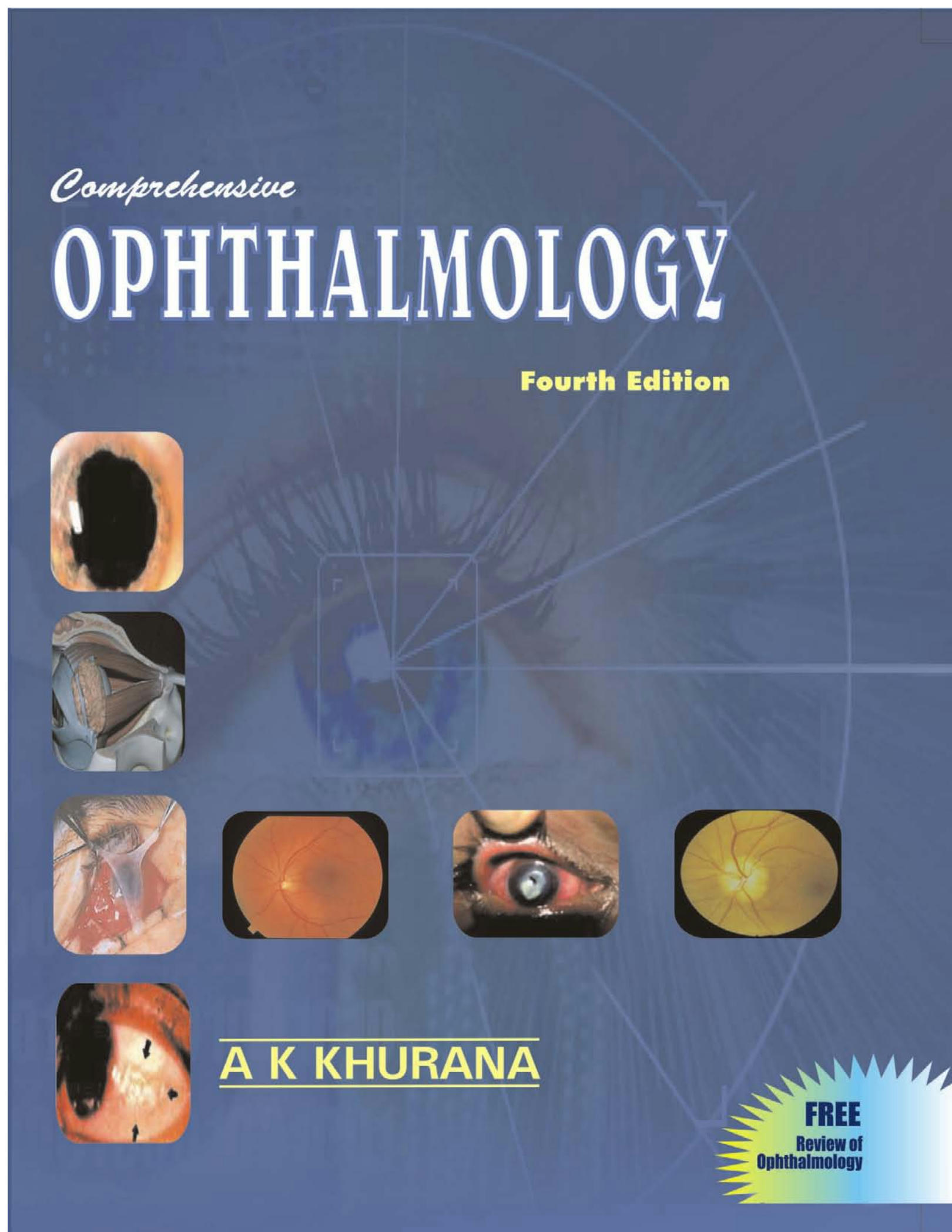
- Khurana A. K. Comprehensive Ophthalmology: 4 th Edition. – New Delhi: New Age International (P) Ltd., 2007. – 616 p
-
Аннотация
Fourth Edition Of The Book Has Been Thoroughly Revised, Updated, And Transformed Into`Comprehensive Ophthalmology`. This Will Meet The Requirements Of Medicalstudents Preparing For Their Final Theory As Well As Practical Examinations Andalso Those Preparing For Various Postgraduate Entrance Tests.Salient FeaturesThe Book Has Been Organized Into Two Sections In An Attractive Colour Format Andis Accompanied With`Review Of Ophthalmology`, As Pocket Companion.Section IAnatomy, Physiology And Diseases Of Eye Includes An Exhaustive And Thorough Exposition Of The Text.Section IiPractical Ophthalmology Provides A Complete And Exact Scheme And Pattern Of Practical Examinations Along With Ready-Made Material Conducive To Quick Comprehension.Review Of Ophthalmology, A Pocket Companion To The Book, Comprises Of Quick Text Review And Multiple Choice Questions Provides An In-Depth Revision At A Glance And An Opportunity For Self Assessment.All These Features Make This An Indispensable Text For Medical Students. Candidates Preparing For Pg Entrance Examinations Would Find It An Authentic Reference Source.
Orthopedics Quick Review for NEET/DNB
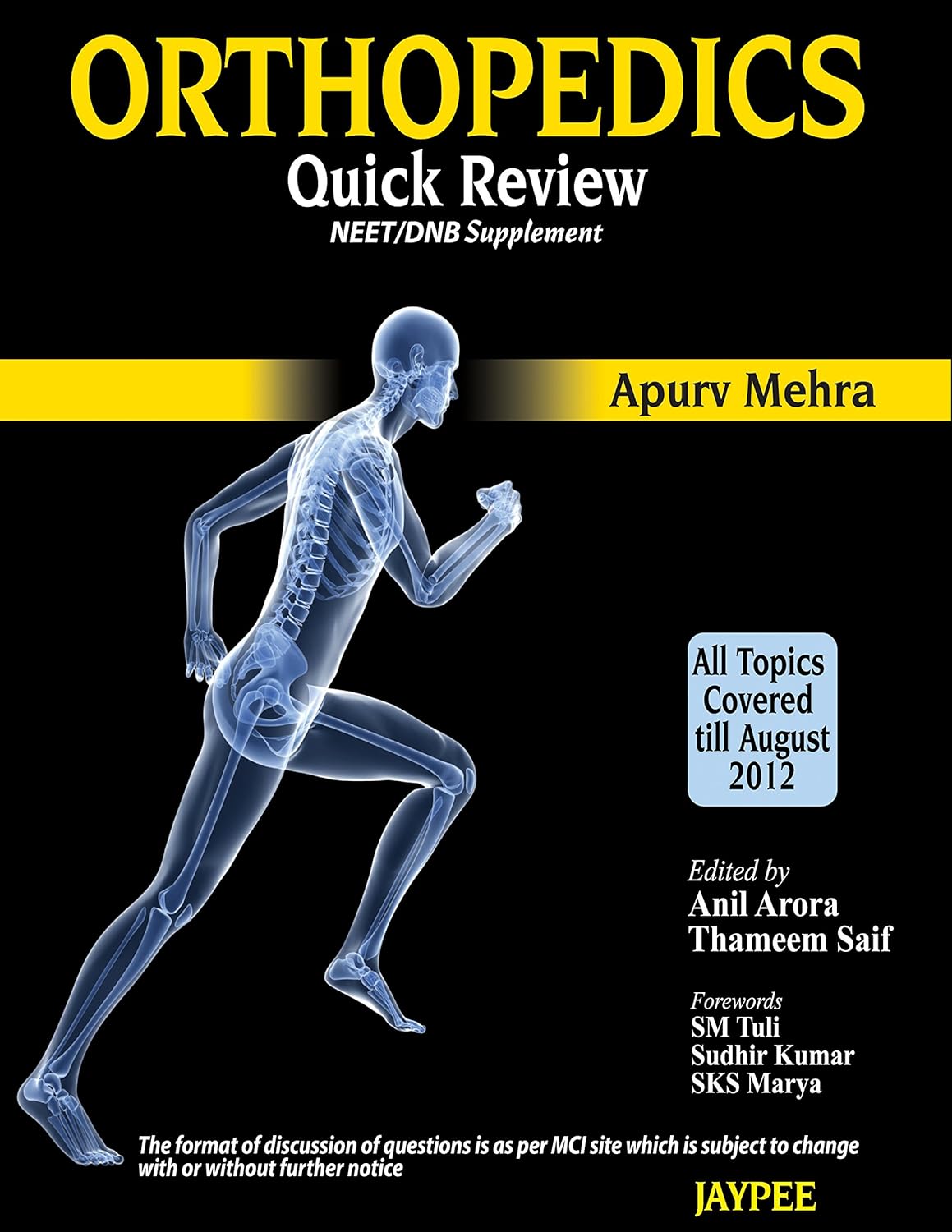
- Apurv Mehra. Orthopedics Quick Review for NEET/DNB: – New Delhi: Jaypee Brothers Medical Publishers (P) Ltd, 2013. – 155 p
-
Аннотация
This book Orthopedics Quick Review (NEET/DNB Supplement) is intended to help the student to quickly review the subject for MCQ examinations. The table of contents of the book covers the wide landscape of orthopaedic discipline. To maintain objectivity and transparency, admissions based upon objective MCQ type of questions is the best of all assessment systems, granting that no assessment system is really “perfect”. This book would help the prospective candidates to channalise their thinking process for the admission tests. The question-answer style of various sections would also help the prospective faculty (who compose the MCQs) to standardise the frame word for constructing the question with least ambiguity and for appropriate level of MBBS graduates.
Essential Orthopaedics
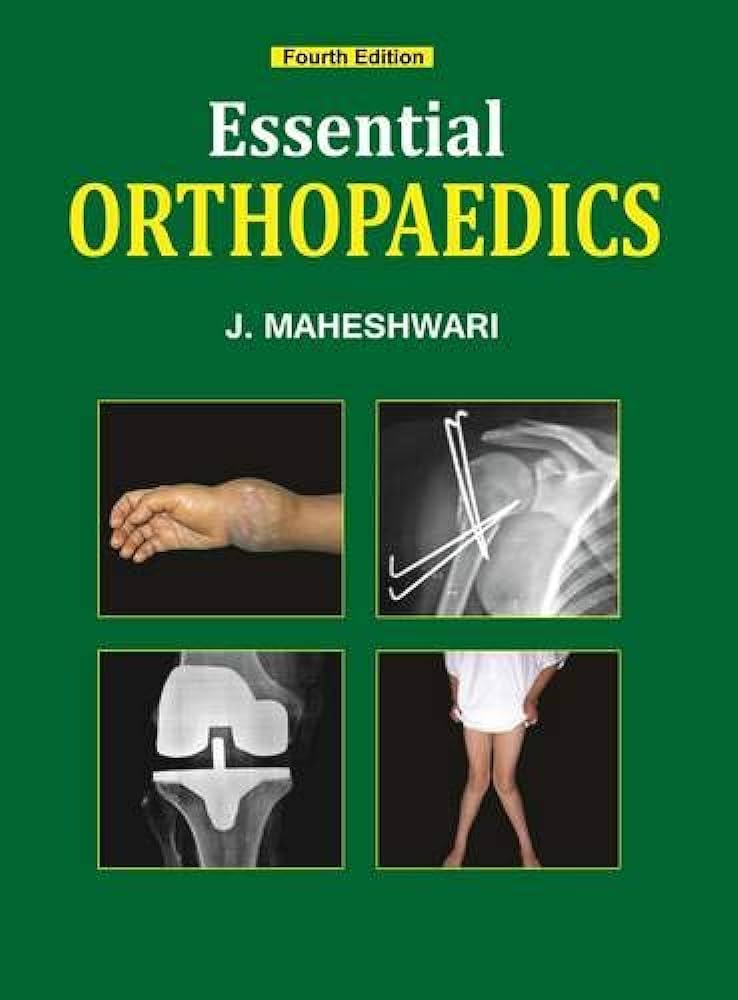
- J. Maheshwari Essential Orthopaedics: 4th Edition. – New York: Jaypee Brothers Medical Publishers (P) Ltd, 2011. – 351 p
-
Аннотация
The fourth edition of Essential Orthopaedics is a thoroughly revised, step by step guide to orthopaedics. It covers numerous different injuries and conditions, with each chapter beginning with a brief review of the relevant anatomy, followed by discussion on the principles and methods of treatment. Each condition described has a treatment plan and a summary of the key learning points at the end of each chapter. Simple line diagrams, self explanatory flow charts and tables supplement the text to help understanding. Sections on instruments and implants, as well as orthopaedic terminology are included.
Textbook of Medical Parasitology

- Textbook of Medical Parasitology: 6th Edition. - New Delhi, 2007. - 242 p.
-
Аннотация
This textbook attempts to present the essential information on parasites and parasitic diseases with emphasis on pathogenesis, epidemiology, diagnosis and control. Every effort has been made to incorporate recent advances in the subject. Useful to students of medicine, teachers, physicians and all others concerned with public health.
Textbook of Pathology
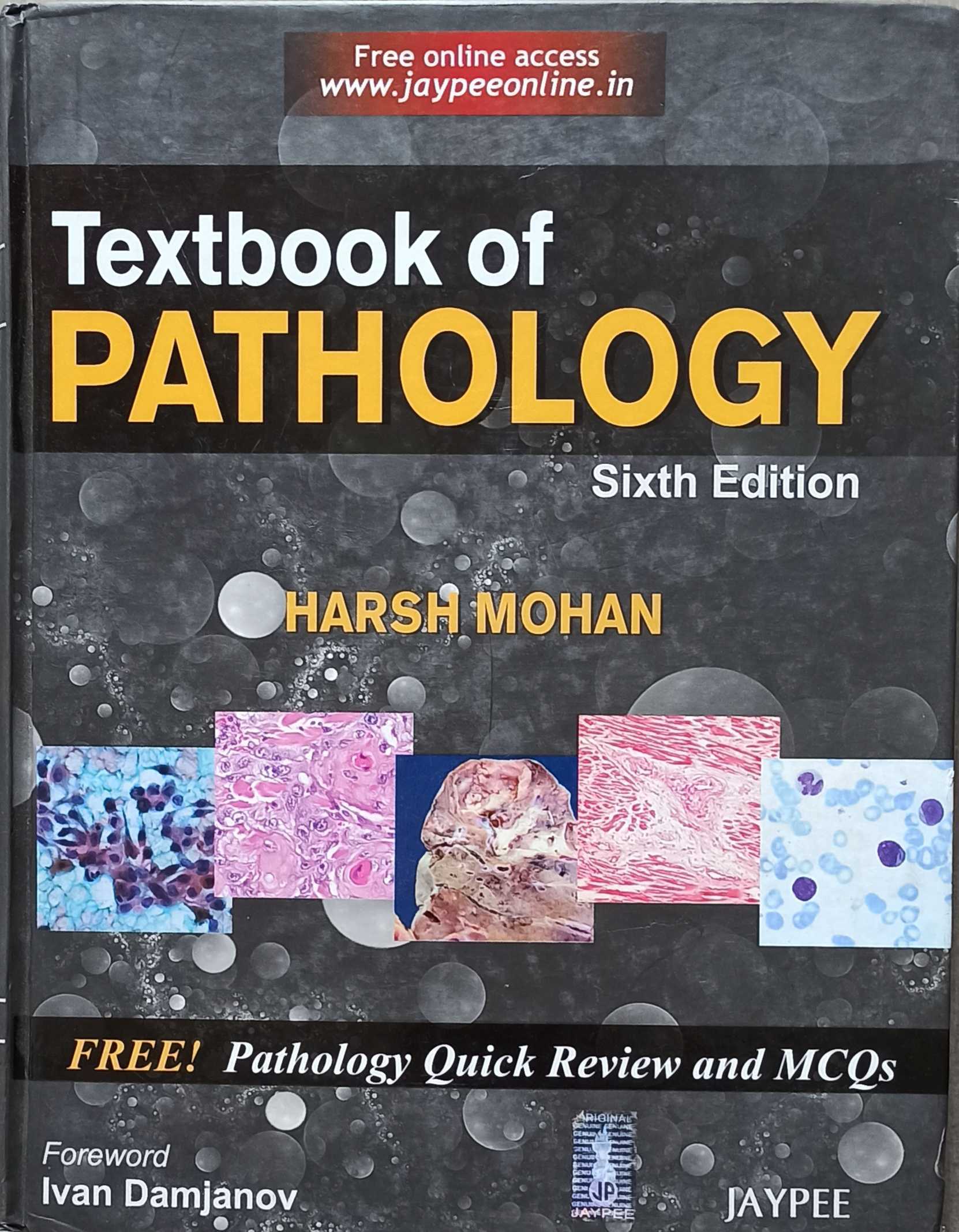
- Harsh Mohan Textbook of Pathology: 6 th Edition. – St Louis: Jaypee Brothers Medical Publishers (P) Ltd, 2010. – 949 p
-
Аннотация
For the Sixth Edition, Dr Mohan has partially restructured the book, substantially revised it, and updated the text wherever it was necessary. Following the advances of basic sciences and clinical pathology, the revisions and addition are most evident in portions pertaining to molecular biology and genetics. Other aspects of modern pathology have not been neglected either and contain numerous novelties; even the seasoned specialists will learn something new from each and every chapter. Furthermore, the author has dramatically increased the number of illustrations, which are so essential for understanding Pathology. The distribution of illustrations has also been changed so that they are now much closer to the text to which they relate.
Robbins and Cotran Pathologic Basis of Disease
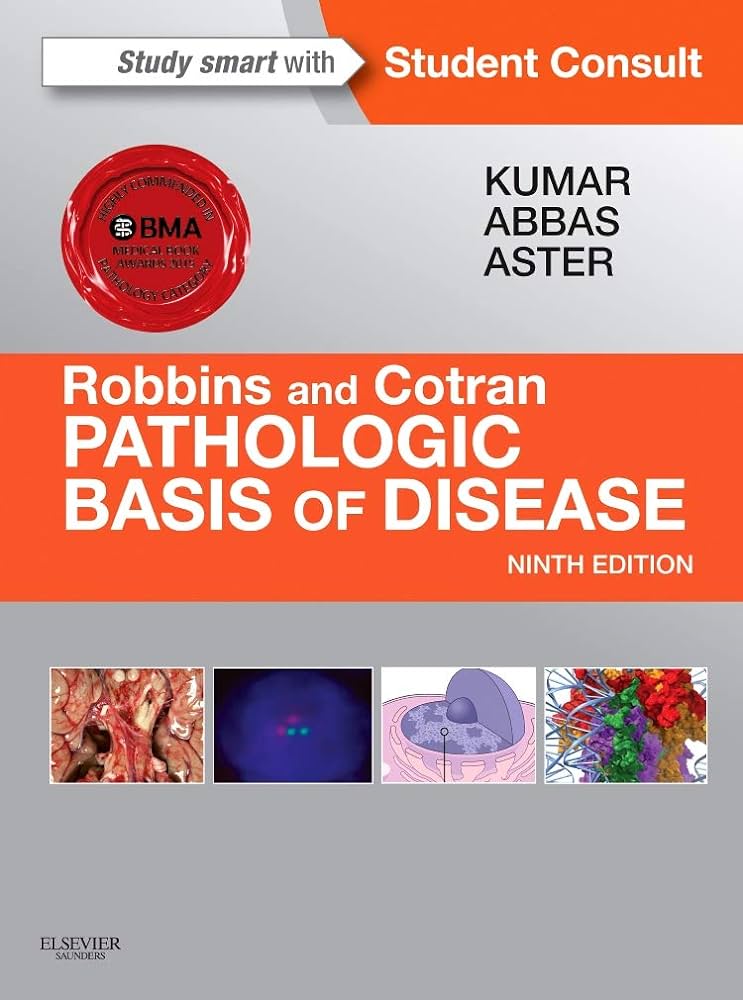
- Robbins and Cotran Pathologic Basis of Disease: 9th Edition - Philadelphia, 2015. - 1392 p.
-
Аннотация
Dependable, current, and complete, Robbins and Cotran Pathologic Basis of Disease, 9th Edition is the perennially best-selling text that you’ll use long after your medical student days are behind you. A world-class author team headed by Drs. Vinay Kumar, Abul Abbas, and Jon Aster, delivers the latest, most essential pathology knowledge in a readable, interesting manner, ensuring optimal understanding of the latest basic science and clinical content. High-quality photographs and full-color illustrations highlight new information in molecular biology, disease classifications, new drugs and drug therapies, and much more.
Nelson textbook of pediatric: Volume 2 set (1, 2)
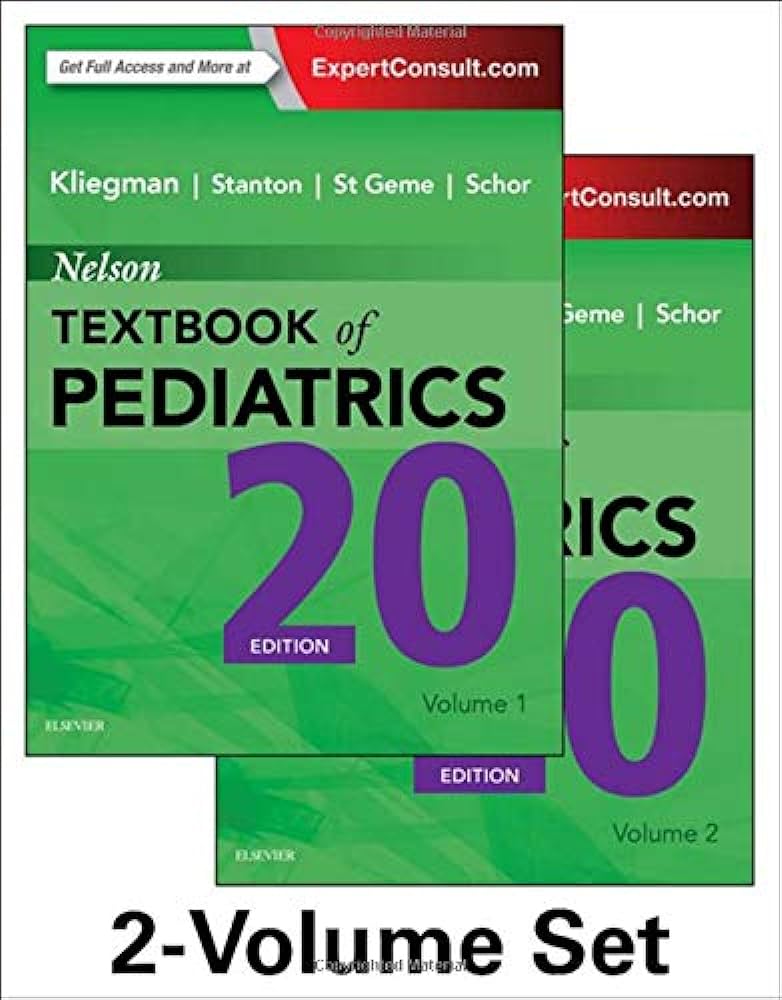
- Robert M. Kliegman, MD Nelson textbook of pediatric: Volume 2 set (1, 2): 20th Edition – New Delhi: Elsevier, Inc., 2016. – 5315 p ISBN: 978-1-4557-7566-8
-
Аннотация
After more than 75 years, Nelson Textbook of Pediatrics remains your indispensable source for definitive, state-of-the-art answers on every aspect of pediatric care. Embracing the new advances in science as well as the time-honored art of pediatric practice, this classic reference provides the essential information that practitioners and other care providers involved in pediatric health care throughout the world need to understand to effectively address the enormous range of biologic, psychologic, and social problems that our children and youth may face. Brand-new chapters and comprehensive revisions throughout ensure that you have the most recent information on diagnosis and treatment of pediatric diseases based on the latest recommendations and methodologies.
A Textbook of Clinical Pharmacology and Therapeutics
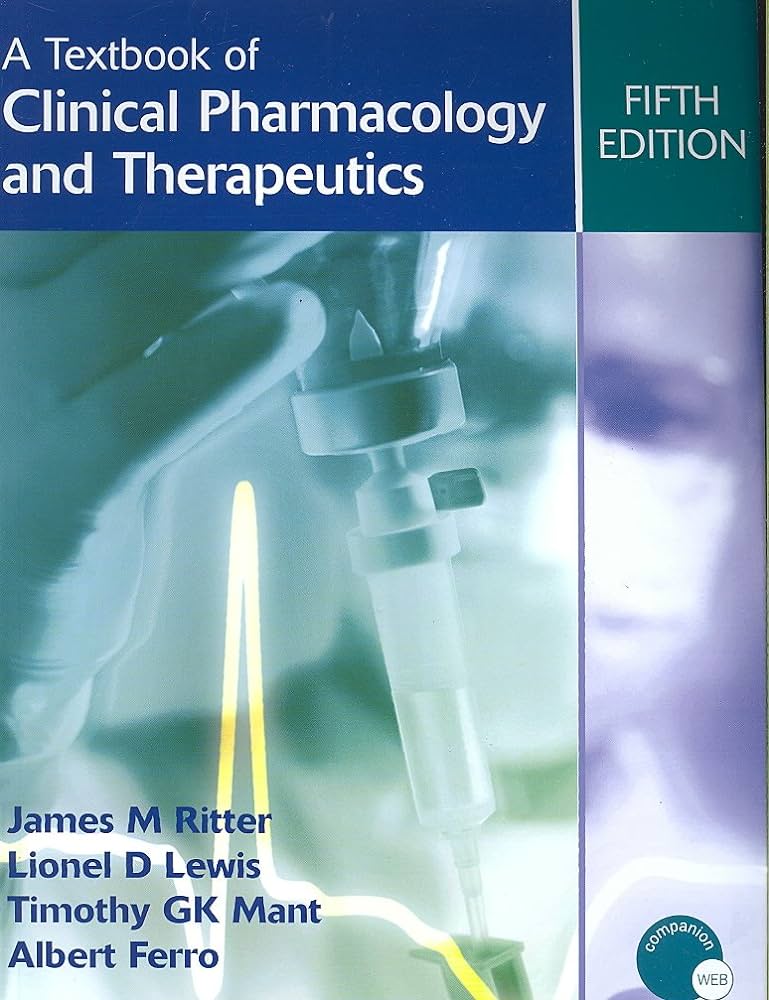
- A Textbook of Clinical Pharmacology and Therapeutics: 5th Edition - London, 2008.- 476 p.
-
Аннотация
Fully revised throughout and extensively illustrated, the fifth edition of this well-established textbook has been streamlined to focus on what medical students and junior doctors really need to know in order to understand the implications of prescribing one drug over, or in combination with, another. The text provides current information on all areas of drug prescribing with updated discussion and guidance on such topics as adverse drug reactions, 'personalized medicine', gene and cell-based therapy, advances in cancer therapy, and mechanisms of drug action and treatment guidelines in HIV and mycobacterial infections therapy. A new chapter on alternative medicines and nutraceuticals has been introduced and Further Reading lists have been updated to include key medical websites.
Basic & Clinical Pharmacology
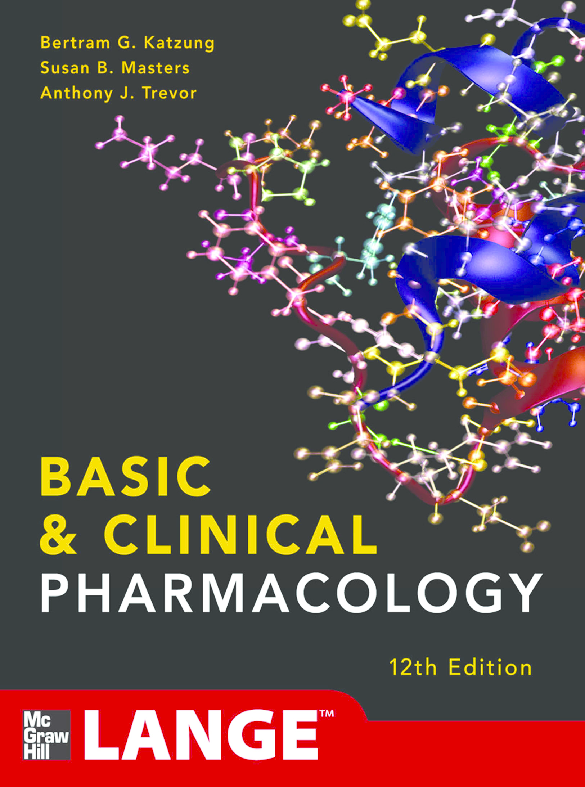
- Basic & Clinical Pharmacology: 12th Edition - McGraw-Hill, 2012. - 1245 p.
-
Аннотация
This edition continues the sequence used in many pharmacology courses and in integrated curricula: basic principles of drug discovery, pharmacodynamics, pharmacokinetics, and pharmacogenomics; autonomic drugs; cardiovascular-renal drugs; drugs with important actions on smooth muscle; central nervous system drugs; drugs used to treat inflammation, gout, and diseases of the blood; endocrine drugs; chemotherapeutic drugs; toxicology; and special topics. This sequence builds new information on a foundation of information already assimilated. For example, early presentation of autonomic nervous system pharmacology allows students to integrate the physiology and neuroscience they have learned elsewhere with the pharmacology they are learning and prepares them to understand the autonomic effects of other drugs. This is especially important for the cardiovascular and central nervous system drug groups. However, chapters can be used equally well in courses and curricula that present these topics in a different sequence.
Lippincott Illustrated Reviews: Pharmacology
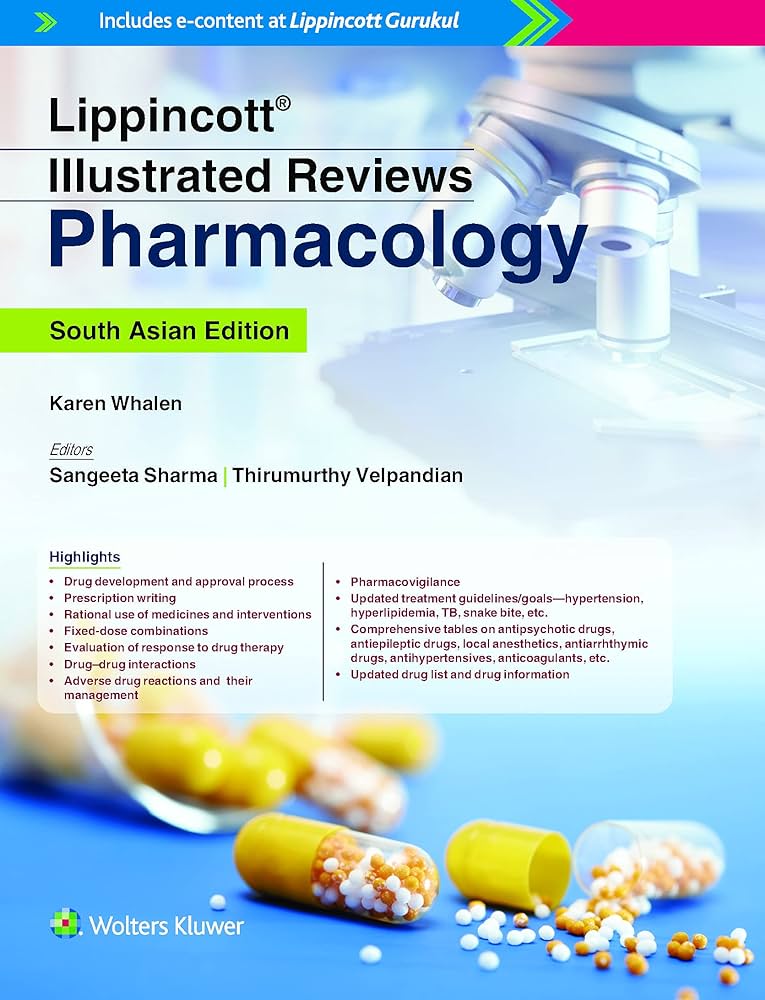
- Karen Whalen Lippincott Illustrated Reviews: Pharmacology: 8th Asian Edition – New Delhi: Wolters Kluwer (India) Pvt. Ltd., 2019. – 881 p
-
Аннотация
Students’ favorite review resource for studying the essentials of medical pharmacology, Lippincott® Illustrated Reviews: Pharmacology, 8th Edition, presents up-to-date drug information in an accessible format ideal for effective review. Part of the popular Lippincott® Illustrated Reviews series, this concise resource features clear writing and hundreds of illustrations that break down complex pharmacological information, so it is understandable and accessible. Sequential images present mechanisms of action and focus on showing rather than telling students how drugs work, and review questions with answers deliver powerful, practical exam preparation.
Ganong’s Review of Medical Physiology

- Ganong’s Review of Medical Physiology: 23rd edition– New York: The McGraw-Hill Companies, Inc. , 2010. - 714 p.
-
Аннотация
"This 23rd edition is an excellent source of the current knowledge in physiology. Significant pedagogical advances have been made while preserving the integrity of Dr. Ganong's work....They have done an excellent job of updating this classic, and the tradition continues. So many students in the future will be able to use this book to enhance their knowledge."--Doody's Review Service For more than four decades, Ganong's Review of Medical Physiology has been the leader in helping medical students and clinicians understand the fascinating subject of human and mammalian physiology. Concisely covering every important topic without sacrificing depth or readability, Ganong's delivers more detailed, clinically-relevant, high-yield information per page than any similar text or review. Thoroughly updated to reflect the latest research and developments in important areas such as the cellular basis of neurophysiology, Ganong's Review of Medical Physiology incorporates examples from clinical medicine throughout the chapters to illustrate important physiologic concepts. Whether you're a student who needs an outstanding review for the USMLE or a physician who wants to keep pace with the ever-changing field of medical physiology, there's no better place to turn than Ganong's Review of Medical Physiology.
Guyton and Hall Textbook of Medical Physiology

- Guyton and Hall Textbook of Medical Physiology: 12th edition. – New York: Elsevier Inc., 2011. - 1090 p.
-
Аннотация
The 12th edition of Guyton and Hall Textbook of Medical Physiology continues this bestselling title's long tradition as one of the world's favorite physiology textbooks. The immense success of this book is due to its description of complex physiologic principles in language that is easy to read and understand. Now with an improved color art program, thorough updates reflecting today's medicine and science, and accessible online at studentconsult.com, this textbook is an excellent source for mastering essential human physiology knowledge.
Guyton and Hall Textbook of Medical Physiology
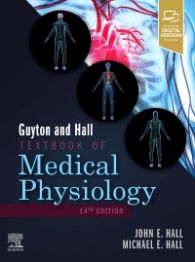
- Guyton and Hall Textbook of Medical Physiology: 14th Edition – New Delhi: Elsevier, Inc., 2021. – 1028 p
-
Аннотация
Known for its clear presentation style, single-author voice, and focus on content most relevant to clinical and pre-clinical students, Guyton and Hall Textbook of Medical Physiology, 14th Edition, employs a distinctive format to ensure maximum learning and retention of complex concepts. A larger font size emphasizes core information, while supporting information, including clinical examples, are detailed in smaller font and highlighted in pale blue – making it easy to quickly skim the essential text or pursue more in-depth study. This two-tone approach, along with other outstanding features, makes this bestselling text a favorite of students worldwide.
Self Assessment & Review ENT
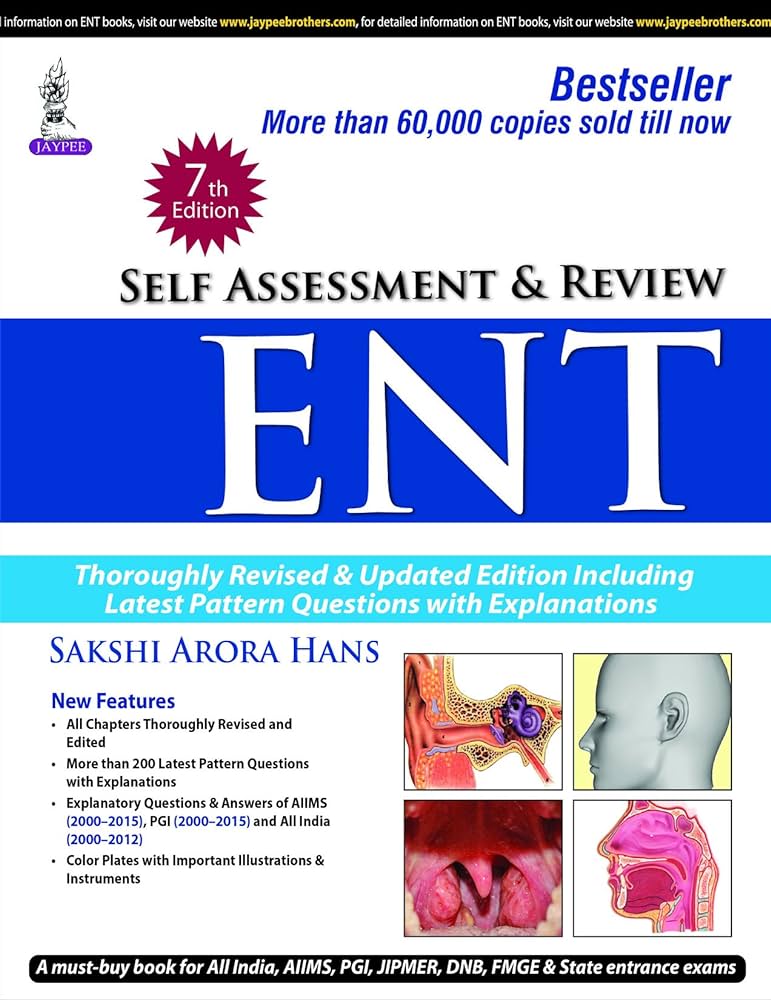
- Hans Sakshi Arora. Self Assessment & Review ENT: 10th Edition. – New Delhi: Jaypee Brothers Medical Publishers (P) Ltd., 2016. – 457 p
-
Аннотация
This book discusses self assessment and review: ENT. This book is designed to provide accurate, authoritative information about the subject matter in question. This book covers the anatomy of ear, physiology of ear and hearing, hearing loss, assessment of hearing loss, assessment of vestibular function, diseases of external ear, diseases of middle ear, Meniere’s disease, otosclerosis, facial nerve and its lesions, lesion of cerebellopontine angle and acoustic neuroma, glomus tumor and other tumors of the ear, rehabilitative methods, anatomy and physiology of nose, diseases of external nose and nasal septum, granulomatous disorders of nose, nasal polyps and foreign body in nose, inflammatory disorders of nasal cavity, epistaxis, oral cavity, anatomy of pharynx, tonsils and adenoids, head and neck space inflammation and thornwaldt’s bursitis, lesions of nasopharynx and hypopharynx including tumors of pharynx, pharynx hot topics, anatomy of larynx, congenital lesions of larynx and stridor, acute and chronic inflammation of larynx, voice and speech disorders, vocal cord paralysis, and tumors of larynx. This book discusses the topic with many flow charts, tables, and mnemonics for better understanding and retaining. To give students an idea of the new questions which could be formed, over 500 new pattern questions have been added, along-side the theory. This will help you to reinforce important points from the topic. These questions are the potential questions for upcoming exams. All important instruments related to surgery, diagrams, X-rays, CT scans have been given along with the topic.
Essentials of Medical Physiology
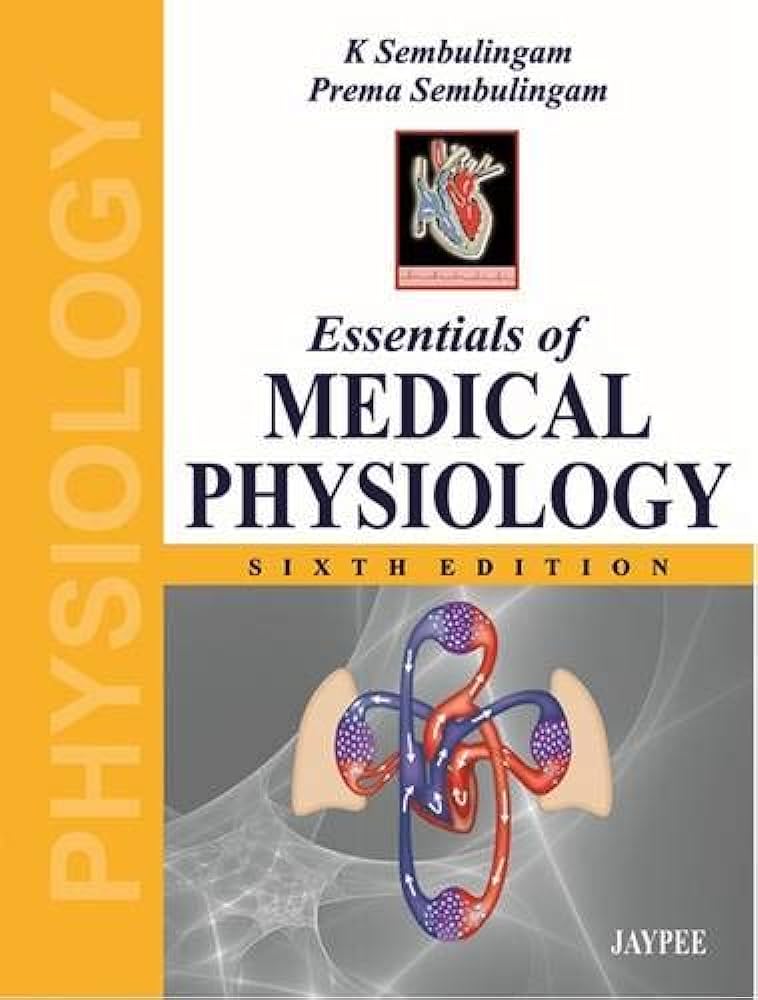
- Sembulingam, K. Sembulingam, Prema. Essentials of Medical Physiology: 6th Edition For Medical Students – – New Delhi: Jaypee Brothers Medical Publishers (P) Ltd, 2012. - 1092 p.
-
Аннотация
This edition is a complete guide to medical physiology for students, covering all aspects of the field, from General to systemic physiology. Each Chapter has been completely revised to reflect the latest developments to provide the most up-to-date information. New sections have been added to the sections of cardiovascular system, muscle physiology and gastrointestinal tract.
The Use of Lateral Thinking
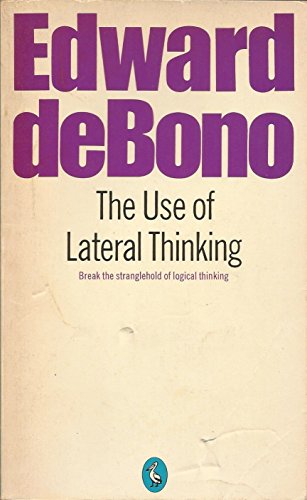
- Edward de Bono. The Use of Lateral Thinking: 1st Edition – New York: Penguin Books Ltd, 1967. – 69 p
-
Аннотация
The author introduces the concept for which he became best known: "lateral thinking"
An Introduction to Philosophy

- Russ Payne An Introduction to Philosophy- Bellevue College, 2015. -129 p.
-
Аннотация
The goal of this text is to present philosophy to newcomers as a living discipline with historical roots. While a few early chapters are historically organized, the goal in the historical chapters is to trace a developmental progression of thought that introduces basic philosophical methods and frames issues that remain relevant today. Later chapters are topically organized. These include philosophy of science and philosophy of mind, areas where philosophy has shown dramatic recent progress. This text concludes with four chapters on ethics, broadly construed. Traditional theories of right action is covered in a third of these. Students are first invited first to think about what is good for themselves and their relationships in a chapter of love and happiness. Next a few meta-ethical issues are considered; namely, whether they are moral truths and if so what makes them so. The end of the ethics sequence addresses social justice, what it is for one's community to be good. Our sphere of concern expands progressively through these chapters. Our inquiry recapitulates the course of development into moral maturity. Over the course of the text, the author has tried to outline the continuity of thought that leads from the historical roots of philosophy to a few of the diverse areas of inquiry that continue to make significant contributions to our understanding of ourselves and the world we live in.
Instruments (Major surgical instruments)
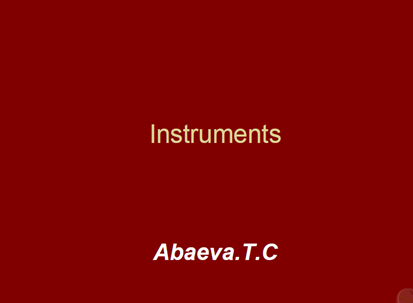
- Abaeva.T.C. Instruments (Major surgical instruments). –25 p
-
Аннотация
Major surgical instruments and photo
Surgical suture
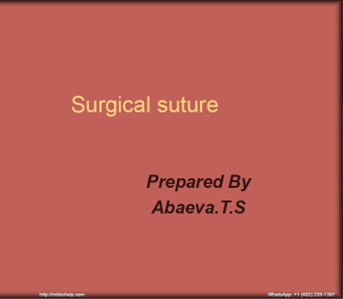
- Abaeva.T.C. Surgical suture: – 18 p
-
Аннотация
Surgical suture is a medical technique used to hold body tissues together after an injury or surgery. It consists of a needle with an attached length of thread. A number of different shapes, sizes, and thread materials
Surgical techniques
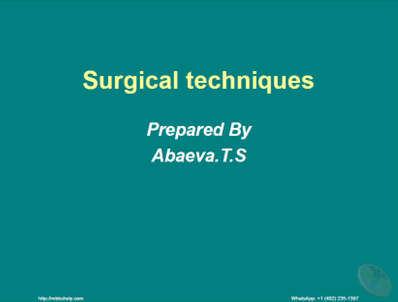
- Abaeva.T.S. Surgical techniques: – 42 p
-
Аннотация
Surgical techniques
Schwartz's Principles of Surgery
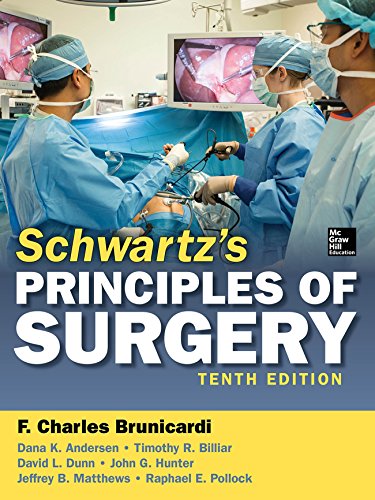
- Charles Brunicardi F. Schwartz's Principles of Surgery: 10 th Edition. – New Delhi: McGraw-Hill Education., 2015. – 2096 p
-
Аннотация
The Tenth Edition of Schwartz's Principles of Surgery maintains the book's unmatched coverage of the foundations of surgery while bringing into sharper focus new and emerging technologies. We have entered a new era of surgery in which minimally invasive surgery, robotic surgery, and the use of computers and genomic information have improved the outcomes and quality of life for patients. With these advances in mind, all chapters have been updated with an emphasis on evidence-based, state-of-the-art surgical care. An exciting new chapter, "Fundamental Principles of Leadership Training in Surgery," expands the scope of the book beyond the operating room to encompass the actual development of surgeons. This edition is also enriched by an increased number of international chapter authors and a new chapter on Global Surgery. More than ever, Schwartz's Principles of Surgery is international in scope--a compendium of the knowledge and technique of the world's leading surgeons.
Sabiston Textbook of Surgery. The Biological Basis of Modern Surgical Practice
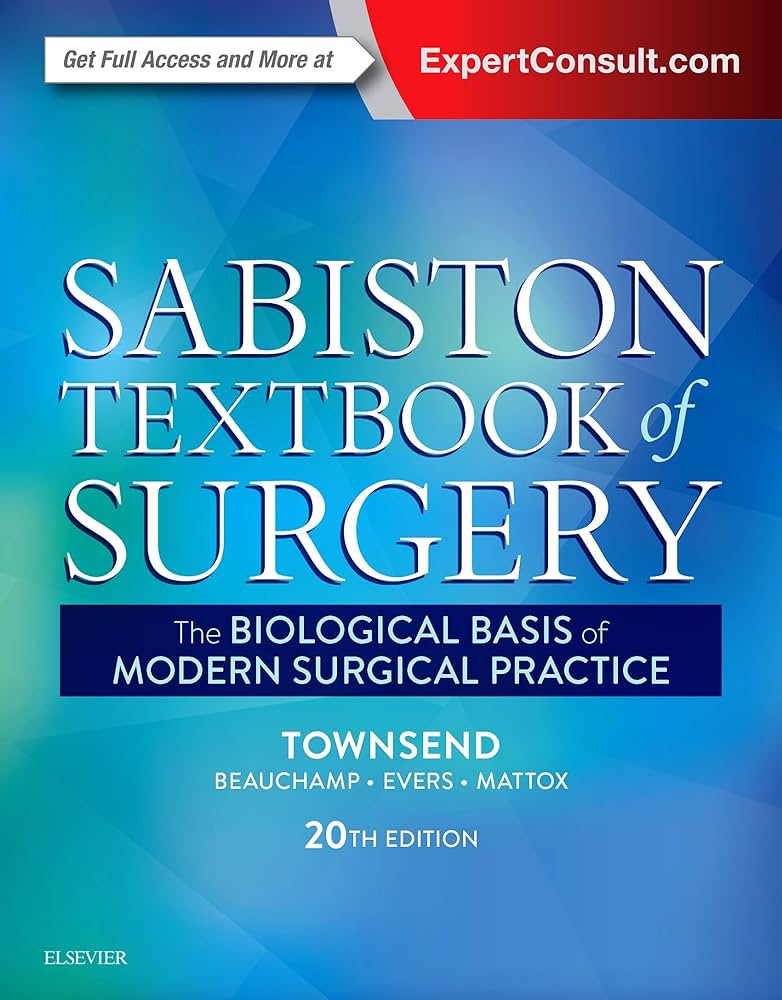
- Courtney M. Townsend. Sabiston Textbook of Surgery. The Biological Basis of Modern Surgical Practice: 20 th Edition. – New Delhi: Elsevier, Inc., 2017. – 2136 p
-
Аннотация
Sabiston Textbook of Surgery is your ultimate foundation for confident surgical decision making. Covering the very latest science and data affecting your treatment planning, this esteemed medical reference helps you make the most informed choices so you can ensure the best outcome for every patient. Consult it on the go with online access at expertconsult.com, and get regular updates on timely new findings and advances. Overcome tough challenges, manage unusual situations, and avoid complications with the most trusted advice in your field. Prepare for tests and exams with review questions and answers online. Keep up with the very latest developments concerning abdominal wall reconstruction, tumor immunology and immunotherapy, peripheral vascular disease, regenerative medicine, liver transplantation, kidney and pancreas transplantation, small bowel transplantation, the continually expanding role of minimally invasive and robotic surgery, and many other rapidly evolving areas.
Clinical Techniques in Surgery
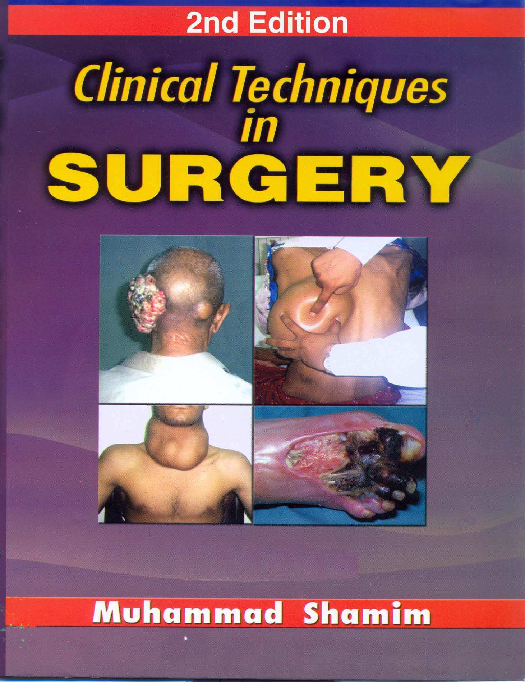
- Dr. Muhammad Shamim. Clinical Techniques in Surgery: 2nd Edition – Karachi: Khurram & Brothers, 2016. – 258 p
-
Аннотация
This book has been written with an eye towards both clinical diagnosis in actual patient management, as well as clinical diagnosis in your own practical exam settings. It represents a departure from the usual physical examination teaching tools which, in their attempts to be all inclusive, tend to de-emphasize the practical nature of patient care. As a result, students frequently have difficulty identifying what information is truly relevant, why it's important & how it applies to the actual patient. By approaching clinical surgery in a pragmatic & demystified fashion, the significance of the material should be readily apparent & the underlying principles more clearly understood.
Bailey & Love's Short Practice Of Surgery
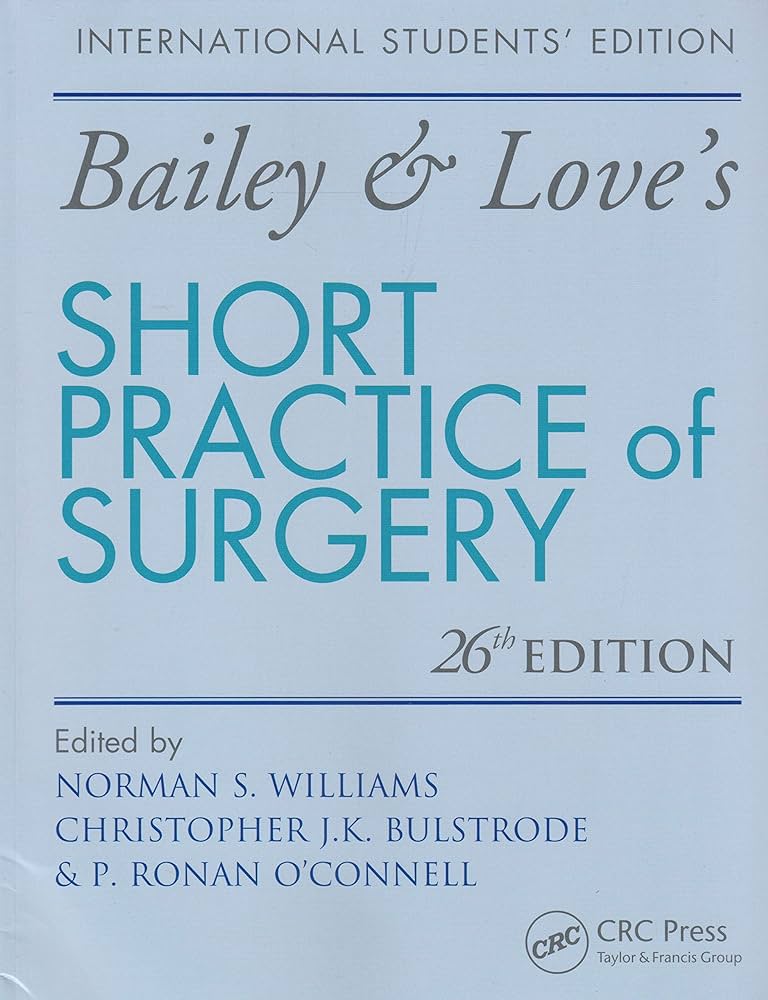
- Norman S. Williams Bailey & Love's Short Practice Of Surgery: 26th Edition. – London: Taylor & Francis Group, 2013. – 1453 p
-
Аннотация
Now in its 26th edition, this textbook's traditional strengths are combined with the latest updates in effective clinical examination and soundly based surgical principles, while taking account throughout of the latest developments in surgical practice.
Diseases of Ear, Nose and Throat & Head and Neck Surgery
- P.L. Dhingra, Shruti Dhingra and Deeksha Dhingra. Diseases of Ear, Nose and Throat & Head and Neck Surgery: 6th Edition – New Delhi: Elsevier, a division of Reed Elsevier India Private Limited, 2014. – 491 p
-
Аннотация
Diseases of Ear, Nose and Throat & Head and Neck Surgery has been regarded as the most sought-after text for the study of ENT. With this eighth edition, the book completes 30 years of service to the students. Since its inception in 1992, it has been widely received by the readers. The eighth edition of the book is thoroughly updated as per guidelines of National Medical Commission in accordance with the competency-based curriculum. Following recent developments and advances in the subject, the book provides essential and conceptual knowledge about disorders of ENT.
Trauma. Chapter 42 (Surgery Essence)
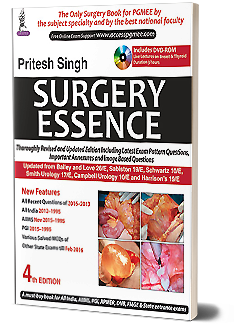
- Pritesh Kumar. Trauma. Chapter 42 (Surgery Essence):– New Delhi: Jaypee Brothers Medical Publishers (P) Ltd., 2016. – 53 p
-
Аннотация
A comprehensive book of multiple choice questions with an extensive coverage of the subject was the need of the time. The questions included in the book are highly informative, with accurate explanations and referencing given for each of them. This book will not only help the entrance aspirants but also help the undergraduate and postgraduate students as MCQs have become an integral part of their written examinations and viva-voce. MCQs are written chapter wise looking into the finer details and for the ease of student’s comprehension. MCQs have high reliability, validity and manageability. They are a precise way of assessing students’ knowledge. This book is divided into ten sections which comprise total 51 chapter. The first section deals with endocrine surgery. Section second and third discusses the hepatobiliary pancreatic surgery and gastrointestinal surgery. Section fourth and five describes the urology and cardiothoracic vascular surgery. Section sixth and seventh covers the plastic surgery and neurosurgery. Section eighth deals with head and neck. Section ninth and tenth discusses the oncology and others surgery.
Атлас анатомии человека: Т. 1
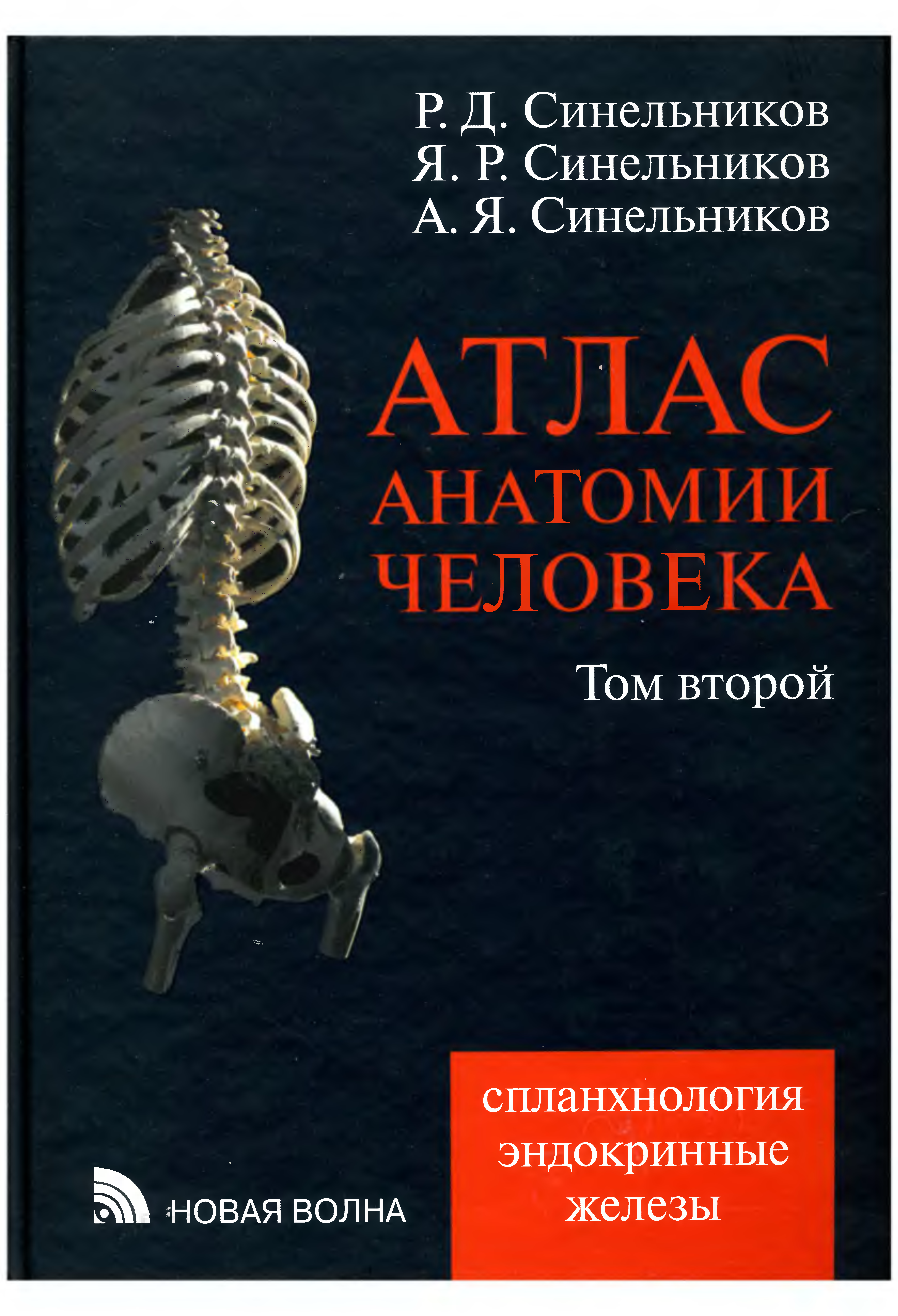
- Синельников Р. Д. Атлас анатомии человека: У чеб. пособие: В 4 т. Т. 1.— 7-е изд., М.: РИА «Новая волна»: Издатель Умеренков, 2009. - 344 с.: ил.
-
Аннотация
В первом томе рассматриваются учение о костях, учение о соединениях костей, учение о мышцах. Отражены взаимоотношения костных образований и прикреп-ляющихся к ним мышц, что позволяет раскрыть скелетотопию особенно сложных мышечных комплексов. Иллюстративный материал представлен рисунками препа-ратов, специально подготовленных для атласа, и рентгенограммами. Все анатоми-ческие термины даны в соответствии с Международной анатомической терминологией (М., Мелицина. 2003). Предназначается для студентов медицинских вузов и специалистов различного медицинского профиля.
Атлас анатомии человека: Т. 2
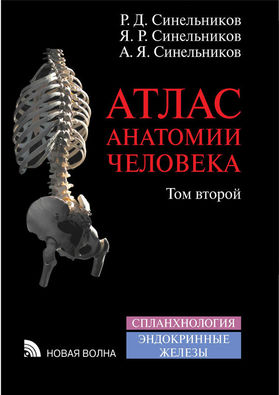
- Синельников Р. Д. Атлас анатомии человека: У чеб. пособие: В 4 т. Т. 2.— 7-е изд., М.: РИА «Новая волна»: Издатель Умеренков, 2009. - 248 с.: ил.
-
Аннотация
Во втором томе рассматриваются учение о внутренностях — пищеварительной, дыхательной, мочевой и половых системах, а также эндокринные железы. Приводятся сведения о развитии и возрастных особенностях органов и систем. Текст иллюстрирован оригинальными рисунками, фотографиями препаратов и рентгенограммами. Все анатомические термины даны в соответствии с Международной анатомической терминологией (М., Медицина, 2003). Предназначается для студентов медицинских вузов и специалистов различного медицинского профиля.
Атлас анатомии человека: Т. 3

- Синельников Р. Д. Атлас анатомии человека: Учеб. пособие: В 4 т. Т. 3.— 7-е изд., М.: РИА «Новая волна»: Издатель Умеренков, 2010. - 216 с.: ил.
-
Аннотация
В третьем томе рассматриваются учение о сердечно-сосудистой системе и лимфоидные органы. Подробно представлены строение сердца, сосуды малого и большого круга кровообращения, лимфатические узлы и сосуды и селезенка; приводятся сведения о их развитии и возрастных особенностях. Текст иллюстрирован оригинальными рисунками, фотографиями препаратов и рентгенограммами. Все анатомические термины даны в соответствии с Международной анатомической терминологией (М., Медицина, 2003). Предназначается для студентов медицинских вузов и специалистов различного медицинского профиля.
Атлас анатомии человека: Т. 4
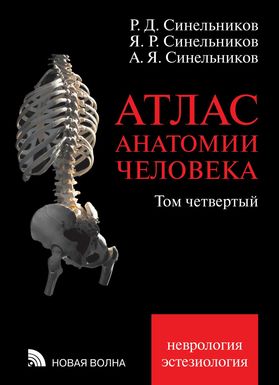
- Синельников Р. Д. Атлас анатомии человека: Учеб. пособие: В 4 т. Т. 4.— 7-е изд., М.: РИА «Новая волна»: Издатель Умеренков, 2010. - 312 с.: ил.
-
Аннотация
В четвертом томе подробно рассматриваются строение, топография, функции и возрастные особенности центральной и периферической нервной системы, а также органы чувств. Текст иллюстрирован оригинальными рисунками, фотографиями препаратов и рентгенограммами. Анатомические термины даны в соответствии с Международной анатомической терминологией (М., Медицина, 2003). Предназначается для студентов медицинских вузов и специалистов различного медицинского профиля.
Lippincott Illustrated Reviews: Pharmacology
- Karen Whalen Lippincott Illustrated Reviews: Pharmacology: 6th Asian Edition – New Delhi: Wolters Kluwer (India) Pvt. Ltd., 2015. – 664 p
-
Аннотация
Lippincott Illustrated Reviews: Pharmacology, Sixth Edition, is the updated, enhanced version of the student favorite resource for essentials of medical pharmacology. The first and best resource, the Lippincott Illustrated Reviews series features clear, effective writing and hundreds of illustrations for ideal rapid review and the assimilation of complex information. Clear, sequential images present mechanisms of action and focus on showing rather than telling students how drugs work. New edition features: All NEW chapters on Drugs of Abuse, Drugs for Obesity, Antihistamines, Drugs for Urologic Disorders, Drugs for Hematopoietic Disorders, Drugs for Dermatological Disorders, and Drugs for Bone Disorders Over 380 study questions! Nearly 600 annotated, full color illustrations visually explain complex processes! Outline format ideal for concise review and foundational learning
Bacterial and Bacteriophage Genetics
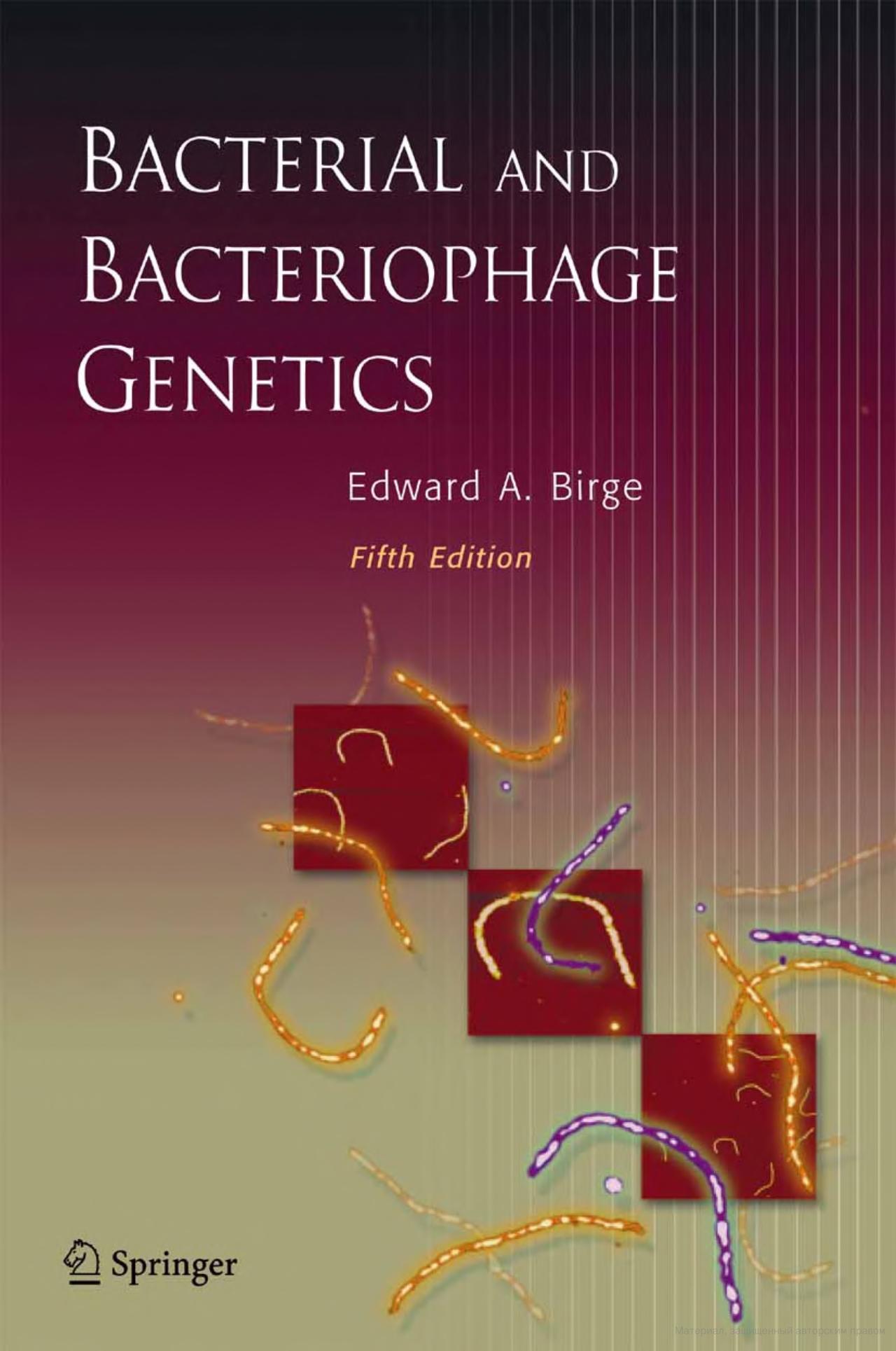
- Edward A. Birge Bacterial and Bacteriophage Genetics: 5th Edition. – Tempe,: Springer Science & Business Media, 2006. - 578 p.
-
Аннотация
Genetic investigations and manipulations of bacteria and bacteriophage have made vital contributions to our basic understanding of living cells and to the development of molecular biology and biotechnology. This volume is a survey of the genetics of bacteria and their viruses, and it provides students with a comprehensive introduction to this rapidly changing subject. The book is written for upper level undergraduates and beginning graduate students, particularly those who have had an introductory genetics course. The fifth edition has been extensively revised to reflect recent advances in the field. The book now has a reader-friendly look, with end-of-chapter questions, "Thinking Ahead" and "Applications" boxes to challenge students’ comprehension and insights. A complete glossary of commonly used terms has been revised and expanded.
Alcamo's fundamentals of microbiology
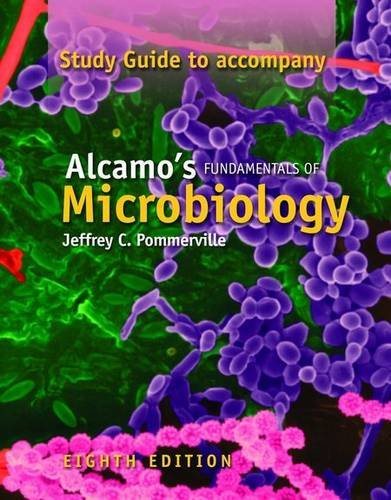
- Pommerville, Jeffrey C. Alcamo's fundamentals of microbiology: 8th Edition. – Sudbury,: Jones and Bartlett Publishers, 2007. - 950 p.
-
Аннотация
Updated with additional material for the new Eighth Edition, this popular lab manual offers thirty-four multi-part lab exercises designed to provide students with basic training in the handling of microorganisms, while exploring microbial properties and uses. This lab manual can also be used independently of the main text. An instructor's manual, downloadable from the Web, accompanies the lab manual and provides principles of lab safety; research topic ideas, information on customizing laboratory programs with the manual; helpful suggestions for setting up and running each exercise; and lists of laboratory media, cultures, and special materials used in each exercise.
A Photographic Atlas for the Microbiology Laboratory
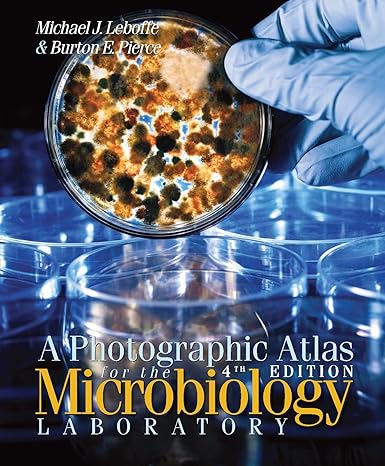
- Michael J. Leboffe A Photographic Atlas for the Microbiology Laboratory: 4th Edition. – Englewood,: Publisher Morton Publishing Company. 2011. - 256p.
-
Аннотация
This full-color atlas is intended to act as a supplement to introductory microbiology laboratory manuals. It is not designed to replace them, nor is it intended to replace actual performance of the techniques. Rather, the photographs are supplied to help with the interpretation of results. The third edition of the Photographic Atlas for the Microbiology Laboratory is one of the best selling microbiology books in the higher education market. The authors have built on the success of this book by making significant improvements for the new edition. Some of the changes for the fourth edition include: A new art program designed to increase student understanding of important concepts A new "Introduction" chapter provides context and background information for the new microbiology student Re-organized content to reflect the "process" a working microbiologist would follow to identify an unknown organism Three new chapters covering the three domains: Bacteria, Archaea, and Eukarya New photographs, re-scanned and or re-imaged photos and new photomicrographs that match more closely what students are likely to observe in the laboratory A complete redesign that should allow the student to better access the material This atlas can accompany and augment any Microbiology textbook. It is designed to be of particular value to students in a laboratory situation and could either accompany a laboratory manual or, in certain courses, it could be used in conjunction with Exercises for the Microbiology Laboratory, Fourth Edition. to provide students with a full-color, affordably priced lab manual. 3-hole drilled.
Histology, Cytology, Embryology
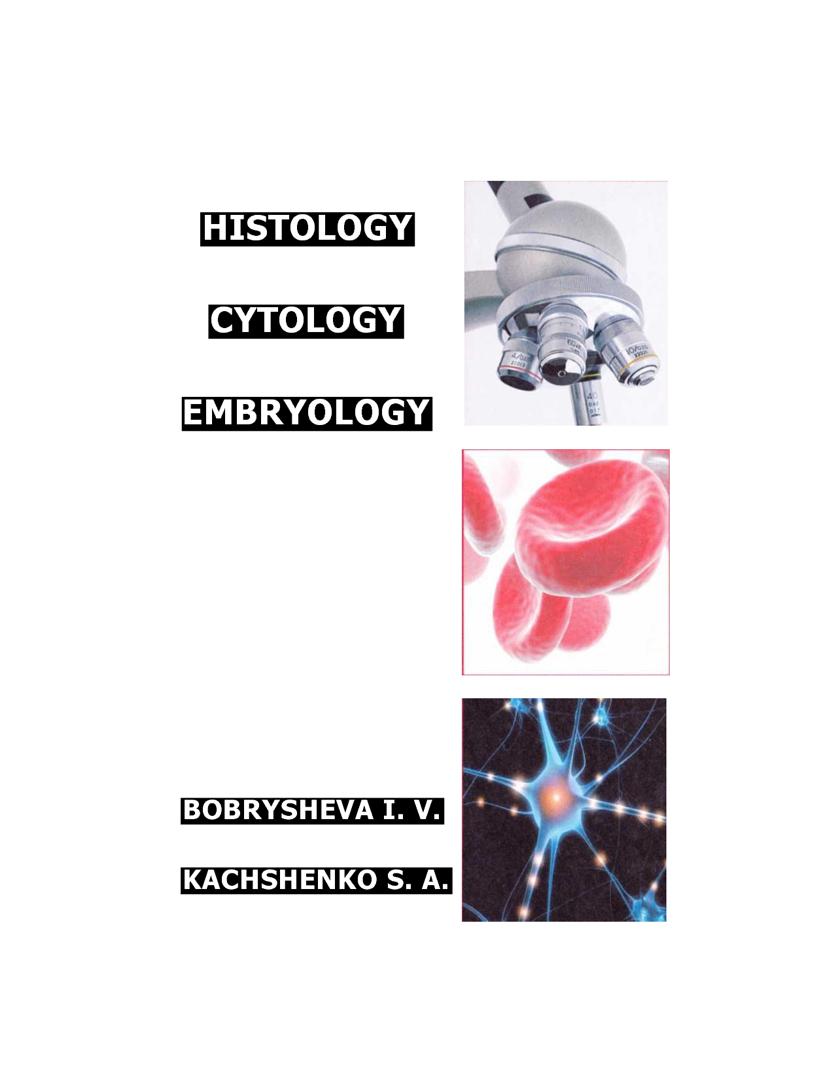
- Bobrysheva I. V. Histology, Cytology, Embryology: Textbook / I. V. Bobrysheva, S. A. Kashchenko. - Lugansk: “Knowledge”, 2011. - 528 p.
-
Аннотация
This text contains the concise thorough presentation of Cytology, Embryology, General and Special Histology, based on modem information of functional morphology of cells, tissues, different organs and systems. This text was created on the basis of the systematized lecture course on Histology, Cytology and Embryology which is delivered at the Histology, Cytology and Embryology Department of State institution «Lugansk State Medical University)) for the students of the Faculties of Medicine and Dentistry. Edition is oriented to the effective learning or revision of course of Cytology, Embryology, General and Special Histology and meant for the students in the health professions and advanced undergraduates.
NMS medicine
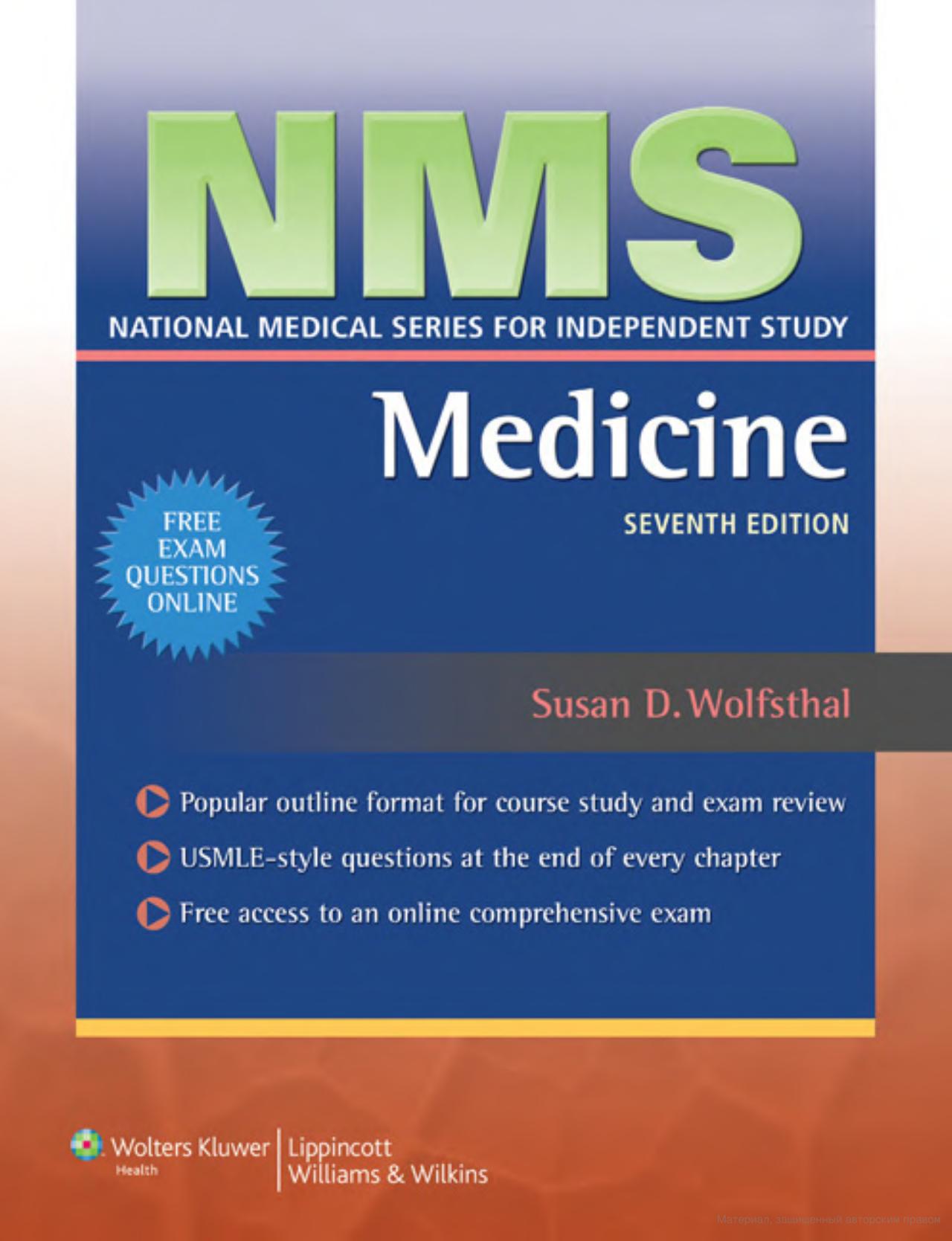
- Susan Wolfsthal. NMS medicine: 7th Edition. – Philadelphia,: Lippincott Williams & Wilkins, a Wolters Kluwer business. 2012.-730p.
-
Аннотация
Care has been taken to confi rm the accuracy of the information present and to describe generally accepted practices. However, the authors, editors, and publisher are not responsible for errors or omissions or for any consequences from application of the information in this book and make no warranty, expressed or implied, with respect to the currency, completeness, or accuracy of the contents of the publication. Application of this information in a particular situation remains the professional responsibility of the practitioner; the clinical treatments described and recommended may not be considered absolute and universal recommendations. The authors, editors, and publisher have exerted every effort to ensure that drug selection and dosage set forth in this text are in accordance with the current recommendations and practice at the time of publication. However, in view of ongoing research, changes in government regulations, and the constant fl ow of information relating to drug therapy and drug reactions, the reader is urged to check the package insert for each drug for any change in indications and dosage and for added warnings and precautions. This is particularly important when the recommended agent is a new or infrequently employed drug. Some drugs and medical devices presented in this publication have Food and Drug Administration (FDA) clearance for limited use in restricted research settings. It is the responsibility of the health care provider to ascertain the FDA status of each drug or device planned for use in his or her clinical practice.
Davidson’s Essentials of Medicine

- J. Alastair Innes Davidson’s Essentials of Medicine: 2nd Edition. – Edinburgh,: Elsevier Inc. 2016. - 860 p.
-
Аннотация
Knowledge and best practice in this field are constantly changing. As new research and experience broaden our understanding, changes in research methods, professional practices, or medical treatment may become necessary. Practitioners and researchers must always rely on their own experience and knowledge in evaluating and using any information, methods, compounds, or experiments described herein. In using such information or methods they should be mindful of their own safety and the safety of others, including parties for whom they have a professional responsibility. With respect to any drug or pharmaceutical products identified, readers are advised to check the most current information provided (i) on procedures featured or (ii) by the manufacturer of each product to be administered, to verify the recommended dose or formula, the method and duration of administration, and contraindications. It is the responsibility of practitioners, relying on their own experience and knowledge of their patients, to make diagnoses, to determine dosages and the best treatment for each individual patient, and to take all appropriate safety precautions. To the fullest extent of the law, neither the publisher nor the authors, contributors, or editors, assume any liability for any injury and/or damage to persons or property as a matter of products liability, negligence or otherwise, or from any use or operation of any methods, products, instructions, or ideas contained in the material herein.
Terapia 2006

- Bartoccioni Sandro. Terapia 2006: 29th ed. – La Treggia, 2005. — 1108 p.
-
Аннотация
Farmacologia Analgesici AntipireticiAntiflogistici Parasimpaticomimetici - parasimpaticolitici Calcioantagonisti Simpaticomimetici Simpaticolitici Digitale Diuretici Anticoagulanti Antiemorragici Antiaritmici Immunosoppressori Antistaminici Psicofarmaci Antitussigeni Antineoplastici immunosoppressori Immunizzazione Antibiotici Chemioterapici ProstaglandineTerapiaFisiopatologia neonatale Alterazioni elettrolitiche Alterazioni dell’equilibrio acido-base Alimentazione parenterale Angina pectorisInfarto del miocardioEdema polmonare acuto ShockEndocardite batterica AritmieMiscellanea cardiologica IpertensioneMalattie vascolariSistema respiratorioOstruzione cronica delle vie respiratorie Asma bronchialeInsufficienza respiratoria «post-traumatica» Embolia polmonare Mucoviscidosi o fibrosi cistica Miscellanea respiratoriaSistema gastro-intestinaleStipsi e diarreaUlcera peptica Colite ulcerosa Morbo di Crohn Epatite virale CirrosiPancreatiteMiscellanea gastrointestinaleSistema emato-poieticoAnemieMiscellanea ematologicaMielolinfopatie neoplastiche Coagulazione intravascolare disseminata e iperfibrinolisi Glomerulopatie Insufficienza renale acuta Insufficienza renale cronica Calcolosi renale Miscellanea urologica Malattie della prostata Malattie da rickettsie e clamidie .Infezioni da batteriMicosi Infezione da protozoiInfezione da elmintiMalattie a trasmissione sessualeMalattie della tiroideDiabeteIpoglicemie e coma ipoglicemicoMiscellanea endocrinologicaIperlipemieObesità Gotta Malattie metaboliche Malattie delle ossa miscellaneaConnettivitiMalattia reumaticaSistema nervosoEpilessiaComaEdema cerebraleMalattie cerebro-vascolari Meningite Cefalee Miastenia Morbo di Parkinson Sclerosi multipla Miscellanea neurologica Miscellanea ostetrico-ginecologicaDisvitaminosiAvvelenamentiMiscellanea dermatologicaUrgenze miscellaneaLe base delle tecniche di pronto soccorsoProdotti erboristici
Comprehensive Cytopathology. Part 1
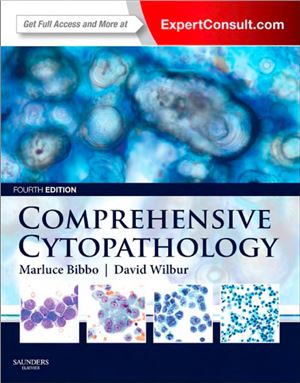
- Bibbo M., Wilbur D. Comprehensive Cytopathology. Part 1: 4th Edition. – London,: Elsevier Inc. 2015. - 532 p.
-
Аннотация
Knowledge and best practice in this field are constantly changing. As new research and experience broaden our understanding, changes in research methods, professional practices, or medical treatment may become necessary. Practitioners and researchers must always rely on their own experience and knowledge in evaluating and using any information, methods, compounds, or experiments described herein. In using such information or methods they should be mindful of their own safety and the safety of others, including parties for whom they have a professional responsibility. With respect to any drug or pharmaceutical products identified, readers are advised to check the most current information provided (i) on procedures featured or (ii) by the manufacturer of each product to be administered, to verify the recommended dose or formula, the method and duration of administration, and contraindications. It is the responsibility of practitioners, relying on their own experience and knowledge of their patients, to make diagnoses, to determine dosages and the best treatment for each individual patient, and to take all appropriate safety precautions. To the fullest extent of the law, neither the Publisher nor the authors, contributors, or editors, assume any liability for any injury and/or damage to persons or property as a matter of products liability, negligence or otherwise, or from any use or operation of any methods, products, instructions, or ideas contained in the material herein.
Conn's Current Therapy (2016)
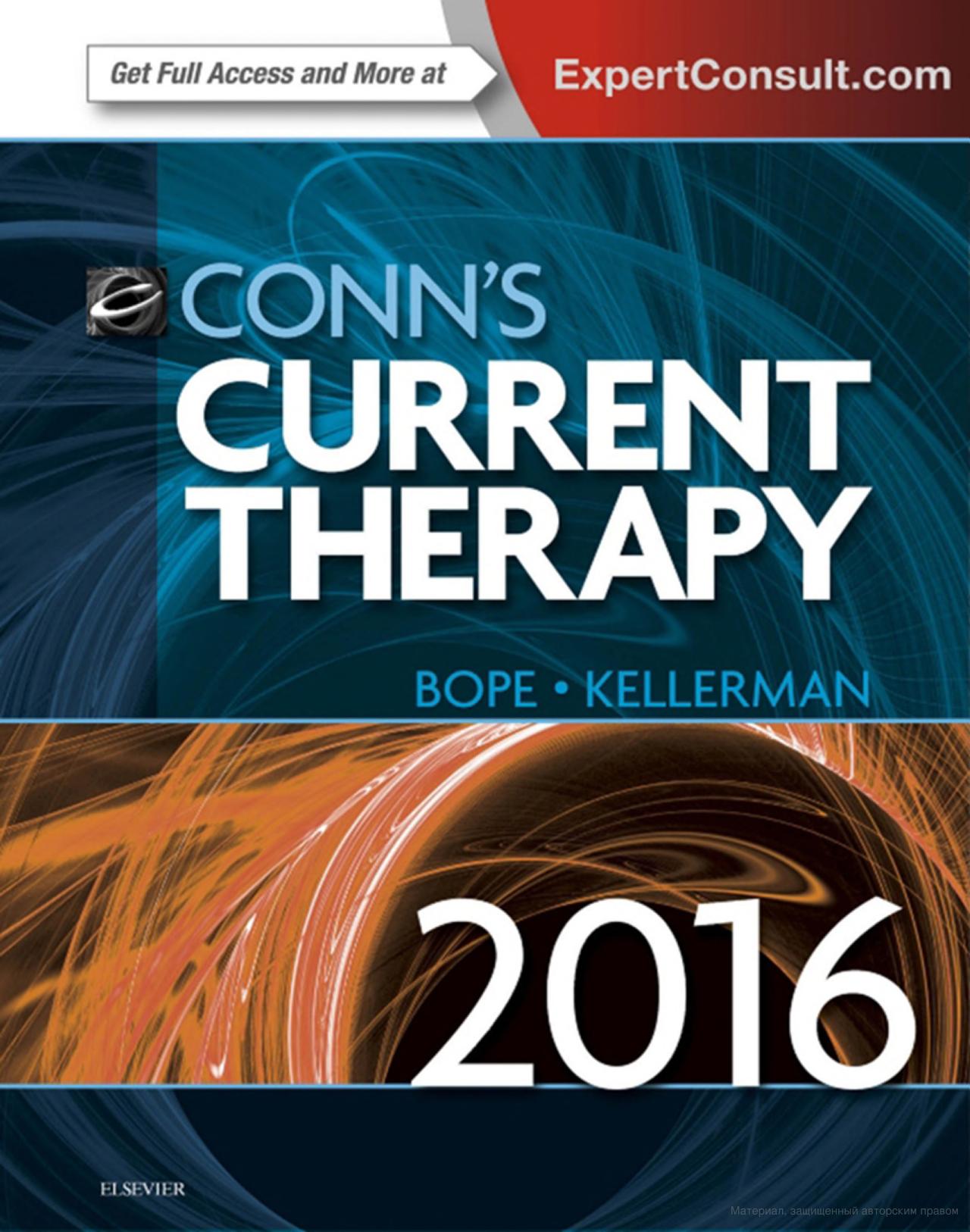
- Edward T. Bope Rick D. Kellerman Conn's Current Therapy (2016) – London,: Elsevier Inc. 2016. - 1314 p.
-
Аннотация
Designed for busy medical practitioners who need a trustworthy, current, and easy-to-use resource, Conn's Current Therapy 2016 focuses solely on up-to-date treatment protocols for the most common complaints, acute diseases, and chronic illnesses.
Comprehensive Cytopathology. Part 2
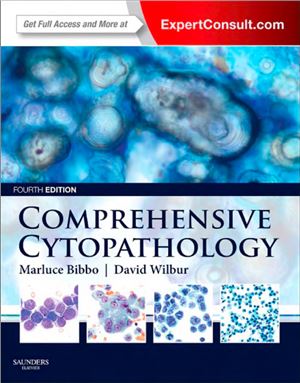
- Bibbo M., Wilbur D. Comprehensive Cytopathology. Part 2: 4th Edition. – London,: Elsevier Inc. 2015. - 553 p.
-
Аннотация
Knowledge and best practice in this field are constantly changing. As new research and experience broaden our understanding, changes in research methods, professional practices, or medical treatment may become necessary. Practitioners and researchers must always rely on their own experience and knowledge in evaluating and using any information, methods, compounds, or experiments described herein. In using such information or methods they should be mindful of their own safety and the safety of others, including parties for whom they have a professional responsibility. With respect to any drug or pharmaceutical products identified, readers are advised to check the most current information provided (i) on procedures featured or (ii) by the manufacturer of each product to be administered, to verify the recommended dose or formula, the method and duration of administration, and contraindications. It is the responsibility of practitioners, relying on their own experience and knowledge of their patients, to make diagnoses, to determine dosages and the best treatment for each individual patient, and to take all appropriate safety precautions.
Bates' Guide to Physical Examination and History Taking

- Lynn S. Bickley Bates' Guide to Physical Examination and History Taking. – Philadelphia,: Lippincott Williams & Wilkins.. 2021. - 1010 p.
-
Аннотация
Learn how to conduct effective physical examinations with the best source of comprehensive, authoritative advice. The physical examination should be performed correctly, and this highly regarded text includes step-by-step instructions that are completely illustrated. It also has an easy-to-read two-column format that correlates examination techniques on the left and abnormalities (clearly indicated in red) with differential diagnoses on the right.
Gray's anatomy : the anatomical basis of clinical practice
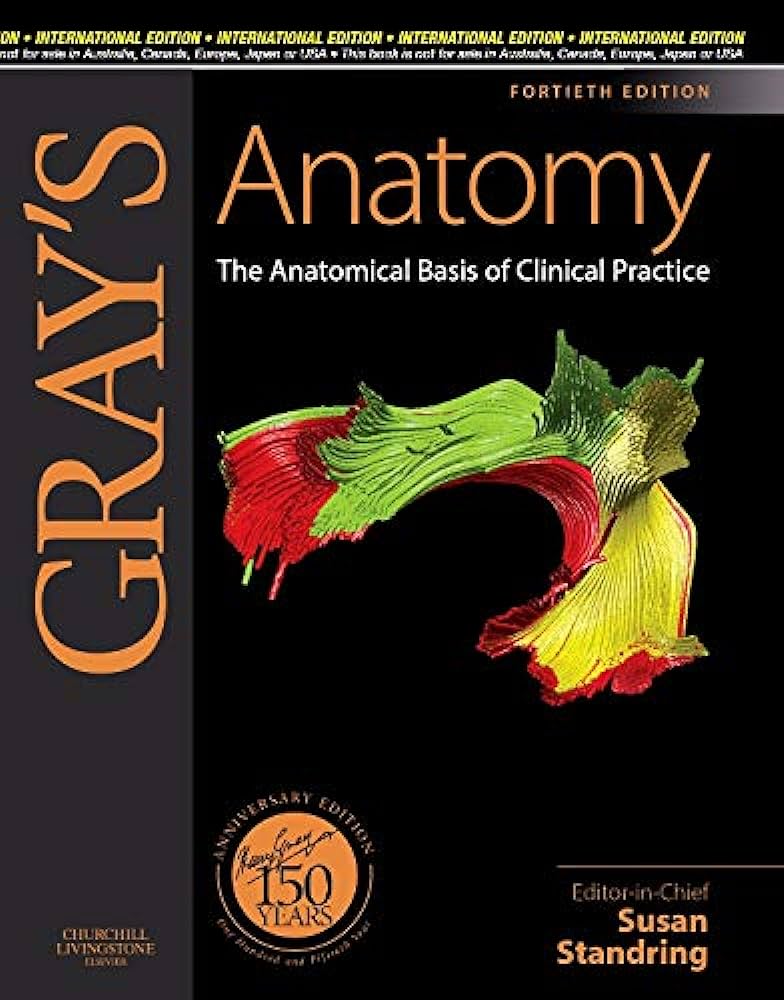
- Susan Standring, Henry Gray. Gray's anatomy : the anatomical basis of clinical practice: 40th Edition, - Edinburgh: Churchill Livingstone/Elsevier, 2008. -1551 p.
-
Аннотация
A universal landmark in medicine ever since Drs. Henry Gray and H.V. Carter published the first edition in 1858, "Gray's Anatomy" now celebrates its 150th anniversary. The new 40th Edition sets a new world standard for accuracy, clarity, and clinical relevance
Harrisons Principles of Internal Medicine Self-Assessment and Board Review
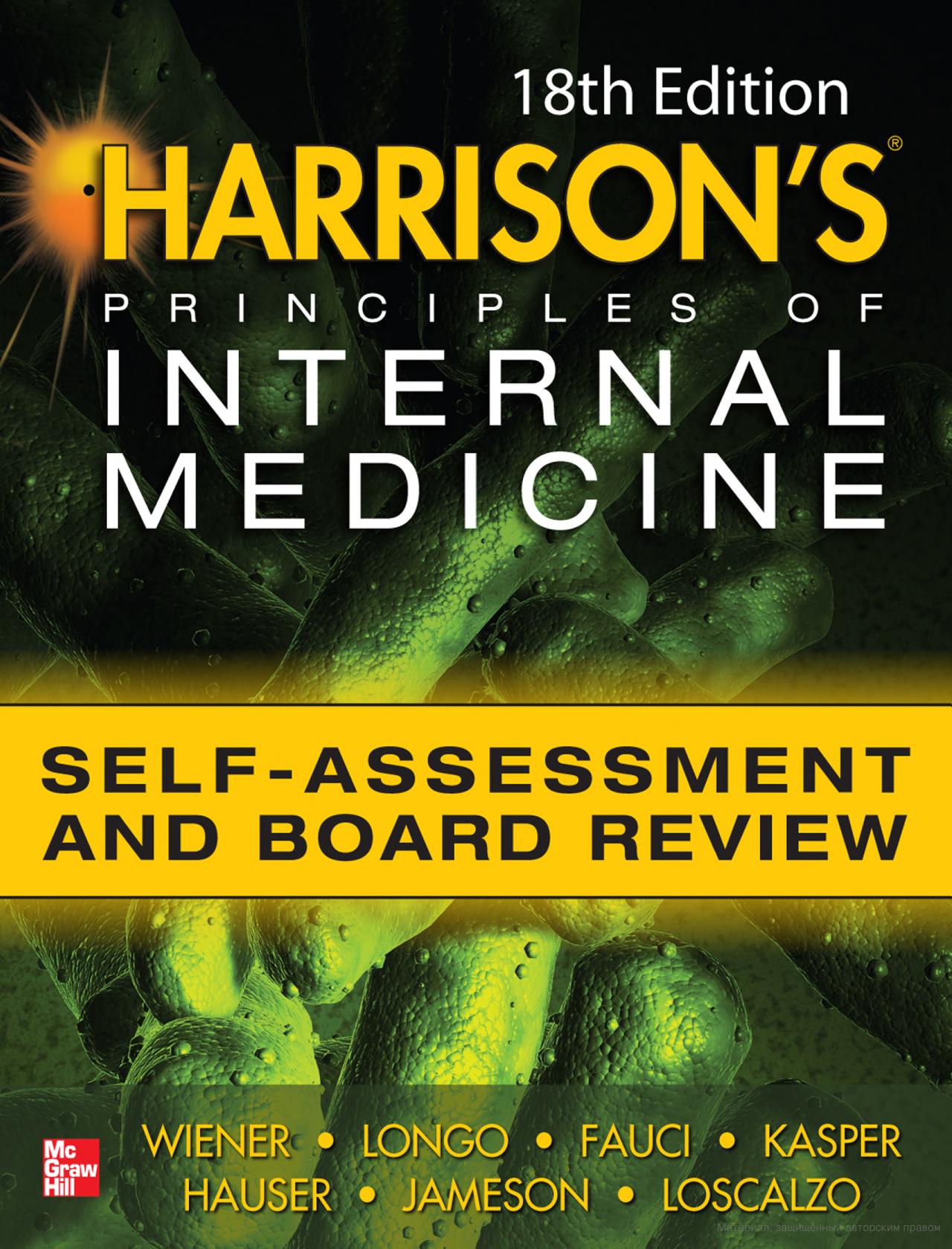
- Harrisons Principles of Internal Medicine Self-Assessment and Board Review : 18th Edition. -New York: McGraw Hill Professional, -2012. -480 p.
-
Аннотация
Based on the content of Harrison’s Principles of Internal Medicine, 18e, this powerful study tool is essential for Internal Medicine Board certification or recertification/maintenance of certification, or as a refresher for any internal medicine examination. Reflecting the accuracy and timeliness of Harrison’s, this complete review of internal medicine features more than 1,100 review questions, many of which utilize realistic patient scenarios, including radiographic or pathologic images. Each question is accompanied by a complete answer and explanation derived from – and cross-referenced to – Harrison’s Principles of Internal Medicine, 18e. These questions are designed to bolster your understanding of pathophysiology, epidemiology, differential diagnosis, clinical decision making, and therapeutics.
Essentials of Medical Pharmacology

- Tripathi KD. Essentials of Medical Pharmacology: 6th Edition. -New Delhi: Jaypee Brothers Medical, -2008. -960 p.
-
Аннотация
The present edition is oriented to reflect the contemporary advancements. All chapters have been updated to include recently introduced drugs and published information. Latest therapeutic guidelines from leading professional bodies, WHO and National Health Programmes have been incorporated, especially in areas like hypertension, hyperlipidaemias, stroke prevention, surgical prophylaxis, tuberculosis, leprosy, malaria, and HIV-AIDS. Recent developments have been highlighted, notably in hormone replacement therapy, aromatase inhibitors, bisphosphonates, selective COX-2 inhibitors, atypical antipsychotics,therapy of diabetes mellitus, heart failure, acute coronary syndromes, Alzheimer’s disease, Parkinsonism, Glaucoma, Kala azar, etc.
Clinically Oriented Anatomy
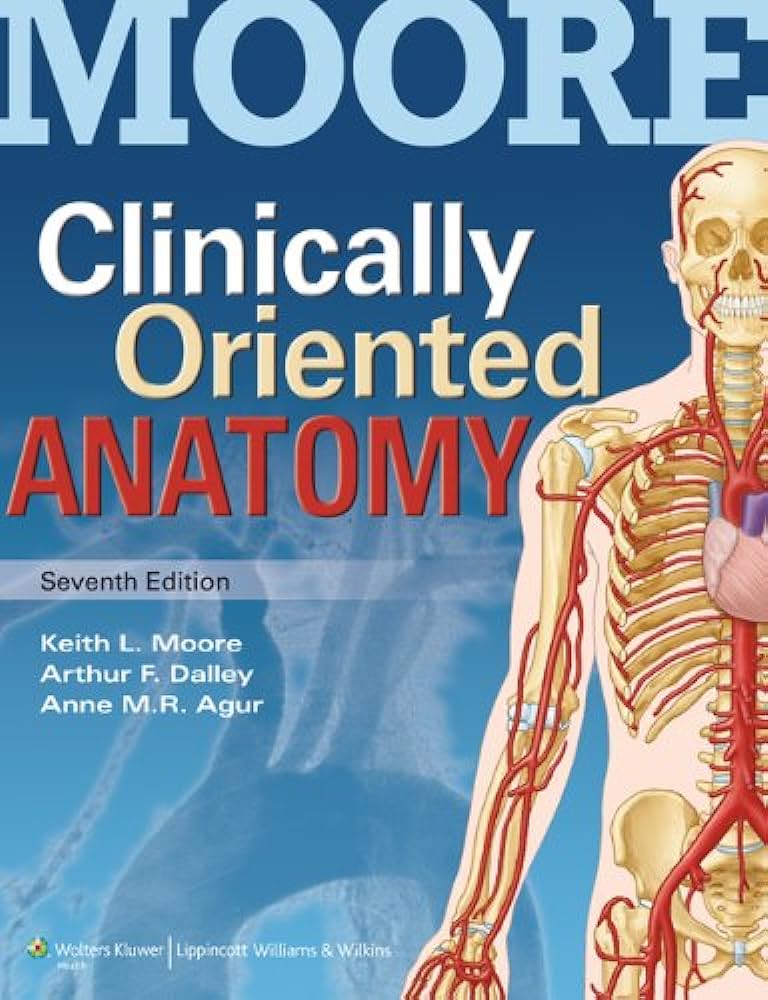
- Keith L. Moore. Clinically Oriented Anatomy: 7th Edition. -Philadelphia: Wolters Kluwer Health/Lippincott Williams & Wilkins, -2014. -1134 p.
-
Аннотация
"Clinically Oriented Anatomy provides first-year medical students with the clinically oriented anatomical information as it relates to the practice of medicine, dentistry, and physical therapy. The 7th edition features a fully revised art program to ensure consistency and cohesiveness of imaging style"--Provided by publisher
Wheater's Functional Histology: A Text And Colour Atlas
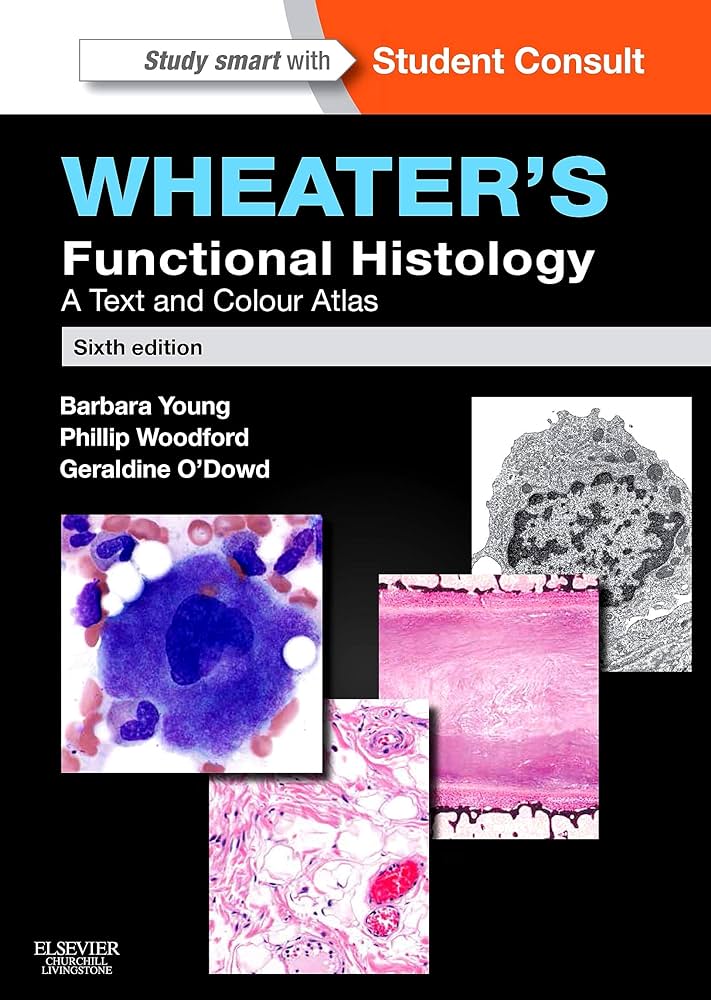
- Young Barbara. Wheater's Functional Histology: A Text And Colour Atlas: 6th Edition – Philadelphia: Elsevier Inc., 2014. – 452 p.
-
Аннотация
Take a simple approach to understanding the fundamentals with Wheater's Functional Histology. Offering concise text accompanied by hundreds of captions and images of histology slides, this best-selling textbook will equip you with all the must-know histology information you need to complete your courses and ace your exams. Recognize the microscopic structure of normal human tissues and how it relates to function with the help of over 900 high-quality histology images and illustrations. Master how to apply histology in a clinical context through coverage of common clinical conditions in each chapter. Access the entire contents online at Student Consult, including all of the images, a virtual histolab, and USMLE-style self-assessment questions and rationales
Selective Anatomy: Prep Manual for Undergraduates. V. I

- Singh Vishram. Selective Anatomy: Prep Manual for Undergraduates. V. I / - 2th. ed.. -New Delhi : "Elsevier Inc", 2015. - 352 p.
-
Аннотация
The second edition of this book is thoroughly updated in accordance with the competency-based curriculum of anatomy. Text is written in simple and easy-to-understand style in question-answer format which helps the student in quick learning and revision. Volume I covers the syllabus of Paper I of University Examination.
Selective Anatomy: Prep Manual for Undergraduates . Volume II.

- Singh Vishram Selective Anatomy: Prep Manual for Undergraduates . Volume II. - 2th. ed.. -New Delhi : "Elsevier Inc", 2015. - 324 р.
-
Аннотация
The second edition of this book is thoroughly updated in accordance with the competency-based curriculum of anatomy. Text is written in simple and easy-to-understand style in question-answer format which helps the student in quick learning and revision. Volume I covers the syllabus of Paper II of University Examination.
Thieme Atlas of Anatomy. Internal Organs

- Schuenke Michael. Thieme Atlas of Anatomy. Internal Organs: 3d. ed. -New York : "Thieme",2020.- 473 p.
-
Аннотация
Thieme Atlas of Anatomy: Internal Organs, Third Edition, Latin Nomenclature, by renowned educators Michael Schuenke, Erik Schulte, Udo Schumacher, along with consulting editors Wayne Cass and Hugo Zeberg, expands on prior editions with increased detail on anatomic relationships of inner organs, and the innervation and lymphatic systems of these organs. Organized by region, the book features 10 sections starting with an overview on body cavities. Subsequent sections cover the cardiovascular, blood, lymphatic, respiratory, digestive, urinary, genital, endocrine, and autonomic nervous organ systems. Regional units covering the thorax and abdomen and pelvis begin with succinct overviews, followed by more in-depth chapters detailing the structure and neurovasculature of the region and its organs.
First Aid for the USMLE Step 1 2024

- First Aid for the USMLE Step 1 2024: Student to Student Guide, – New York: McGraw-Hill Companies, 2024. -848 p.
-
Аннотация
The new edition of First Aid for the USMLE Step 1 is filled with 1,000 color clinical images, including more depicting diverse patients; 1,300+ high-yield facts and mnemonics, organized into basic principles and organ system; and invaluable test-taking advice. There’s a reason for the longstanding success of First Aid for the USMLE Step 1.
The Developing Human

- Moore Keith T. The Developing Human: 10th Edition, Clinically Oriented Embryology Torchia, . – Philadelphia: Elsevier Inc., 2016. -524p
-
Аннотация
Written by some of the world's most famous anatomists, the 10th edition of The Developing Human: Clinically Oriented Embryology continues to present medical students with a comprehensive and easily digestible review of this complex topic. Clearly written and well-structured descriptions include just the information that’s needed, while nearly 600 illustrations help provide a clinically oriented guide to human development, utilizing a week-by-week and stage-by-stage approach to describe fetal organ and system development.
